

Top 10 largest Catamarans in the world
Characterised as a multi-hulled watercraft, a catamaran is a marine vessel comprising two proportioned hulls giving her greater stability and manoeuvrability. Catamarans also have a shallow draft which enables them to enter unexplored regions beyond the reach of sailing yachts or cruise ships.
Their invention is attributed to the Austronesian peoples of Southeast Asia, while the first European Catamaran was built in the 16th century by scientist William Petty. Capable of attaining greater speeds, catamarans are used for recreational sailing, cruising and racing. Modern Catamarans have luxurious features and marvellous design, which makes them enticing.
Let us have a look at the top 10 biggest catamarans in the world.
Table of Contents
1. Hodor ( 217 Ft.)
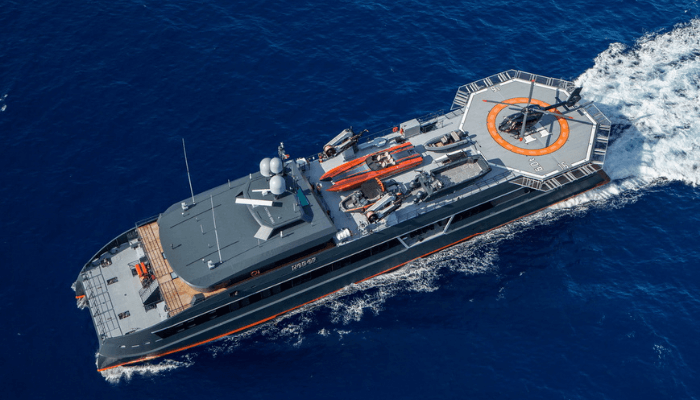
Renowned as the world’s largest floating toy box, the 66.2 m long SHADOWCAT Hodor was built by Astilleros Armon in Spain. Incat Crowther and YCTS. Ltd worked on her functional design and naval architecture, while the interiors were chosen by Oliver Design. Painted grey with vibrant orange lines running across its hull, the catamaran is as robust as it looks.
Launched in 2019, she has a maximum sailing speed of 22.5 knots derived from two MTU diesel engines. With a 14-metre beam, she has a gross tonnage of 1525 tonnes respectively. In terms of LOA, she ranks among the top five per cent in the world. She defeats her counterparts both by average speed and volume.
She is donned with aluminium; her hull, deck and even superstructure are made of this malleable and corrosion-resistant metal. Presently sailing under the flag of the Cayman Islands, Hodor is a treasure-house of water sports gear, filled with nine jet skis, four water bikes, laser dinghies, snorkelers, fishing equipment etc.
The empty space below the main deck is reserved for the Seamagine Aurora-3 submersible which will be delivered soon. Its main attraction is the 17-metre Nor-Tech 560 sports centre console attached to a hydraulic lift system for putting it in water. The largest catamaran is managed by 20 crew members and staff.
2. Sunreef 49 Power Cat ( 160.8 Ft)
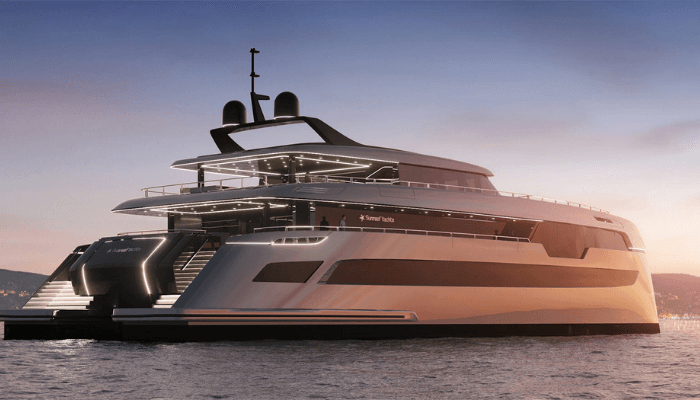
Constructed by the Polish builder Sunreef Yachts, the multihull was fitted in Gdansk and delivered in 2021. Flaunting a classy white exterior, it is an embodiment of cutting-edge marine technology and fresh naval design.
It has three decks and expansive outdoor areas, including an open bar, a swimming pool, a helipad and a forward terrace. Its sun deck lounge has a spa pool, sun pads and even a saloon. With a broad beam of 16.85 metres, the yacht has 8 cabins which comfortably sleep 17 crew personnel and offers luxury accommodation for 11 guests. Five bedrooms on the main deck are equipped with a private balcony.
Low drag, a consequence of the specially designed twin-hull, makes the catamaran glide gracefully on the water while optimising efficiency and low fuel consumption. It has a 90,000-litre fuel tank which enables the power cat to cover 5000 nautical miles without a stopover. Driven by two 3400 HP engines, the superyacht has a top speed of 21 knots and carries three tenders, water sports gear and several jet skis.
3. Charley ( 150 Ft.)
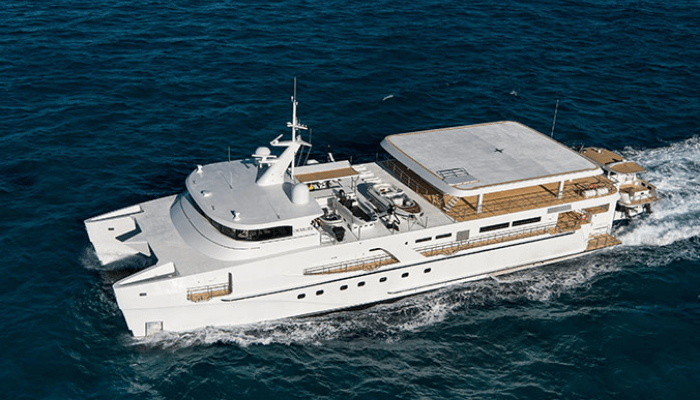
Charley was launched in 2016 as a support yacht to serve the superyacht White Rabbit Gulf, both constructed by the shipbuilding company Eco Yachts. The 46 m long and 14 m wide catamaran has a white exterior, three teak decks and modern fittings. Its naval architecture, interiors and exterior design were taken care of by LOMOcean.
Labelled as the largest composite resin-infused yacht made in Australia, Charley was carefully assembled near Fremantle. With a volume of 702 gross tonnes, she has spacious interiors and outdoor entertainment areas to keep her guests engaged.
However, her most attractive feature is the 12-metre long tender catamaran called Vicky, equipped with a platform located at Charley’s stern. It can store some RIBs, tenders, personal watercraft and one hovercraft.
Propelled by two 2,700hp Cummins QSK60 engines and two propellers, Charley has a 60,000-litre fuel tank which enables her to travel 2,500 nautical miles at the cruising speed of 16 knots.
She has a 3.2 m draft which allows her to traverse shallow bays and narrow canals or even cruise near the shoreline. Possessing a GRP hull and superstructure, Charley has three suites for taking in 5 guests.
4. Moecca ( 148 Ft.)
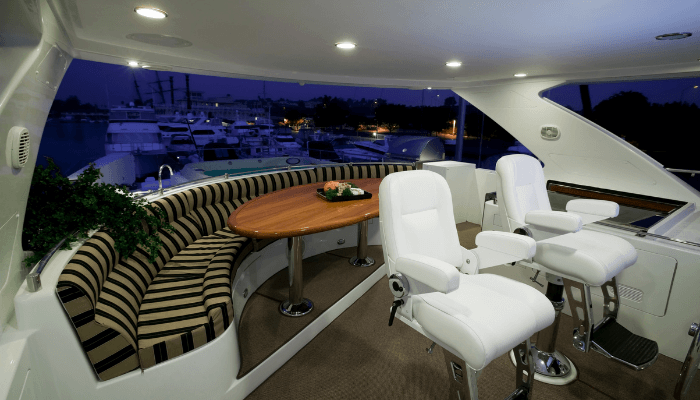
The catamaran motor yacht Moecca was constructed by Oceanfast yachts in Australia. Designed to provide a luxurious sailing experience with moderately-decorated functional spaces, it has a simplistic classic exterior. Delivered in 1992, it underwent maintenance and repair in 2006. Refurbished in the same year, Moecca is fully air-conditioned, having expansive outdoor areas for sunbathing and relaxing.
Her curves are spectacular, thanks to Bannenberg Designs Limited, which crafted her exterior while Phill Curran was responsible for naval architecture. Having a 13 m or 42.7 feet beam, she has seven suites that conveniently accommodate 12 guests and six small yet well-furnished cabins for 11 crew members.
Its spacious salon has two seating areas, a home-theatre set-up and a 12-seater alfresco dining room connected to a bar and a refrigeration room. Her aft deck is enriched with circular sofas and side tables. More open space is provided on the upper deck, which incorporates an open pool and a small workout space. All these amenities are curated by the English design house Bannenberg and Rowell.
She can travel 2200 nautical miles at a maximum speed of 25 knots, achieved by two powerful MTU diesel engines. Moecca is sturdy yet elegant, with a green aluminium hull and a GRP superstructure. Her sides are panelled with mildly-fragrant wood. She has a 1.8 m draft and water tanks capable of storing 15,000 litres of fresh water.
5. HeySea Vista ( 140 Ft.)
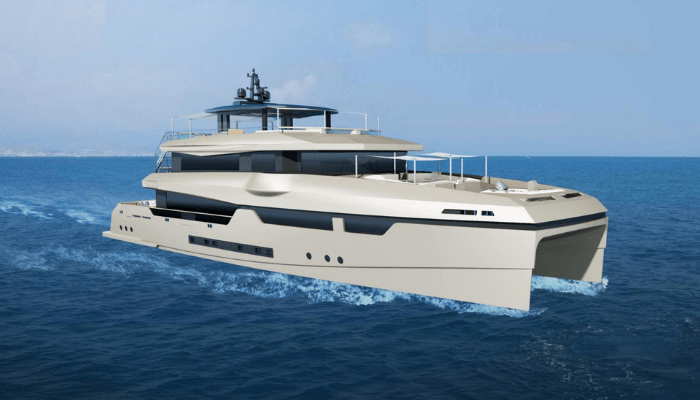
Launched in 2020, the golden hulled Vista is an amalgamation of absolute royalty and finesse. Constructed by the Hey Sea Yachts Group, a prominent yacht manufacturer in China, Vista is a fully custom-designed project built in a 66,700 square m shipyard lying in the Pearl River Delta region near Hong Kong. One of the most challenging aspects of its construction was to attain a perfect shimmering gold finish, achieved by delicate yet continuous polishing.
Her stylish appearance and functional naval design were crafted by the Heysea marine architects and interior designers. The twin-hull allows for voluminous interiors carefully chosen by Horizontal Design to match her stunning fibreglass superstructure.
Vista is adorned with beautiful paintings showcasing marine life, modern art pieces and metallic fittings. She has five bedrooms that comfortably sleep 10 people. The yacht is managed by a 15-member crew.
Coming to the technicalities, she is driven by two Volvo 725 HP engines allowing her to reach a top speed of 15 knots. The vessel can go up to 4000 nautical miles at a cruising speed of 10 knots. Vista has been the biggest project of HeySea, which brought her international appreciation.
6. Sarha ( 137 Ft.)
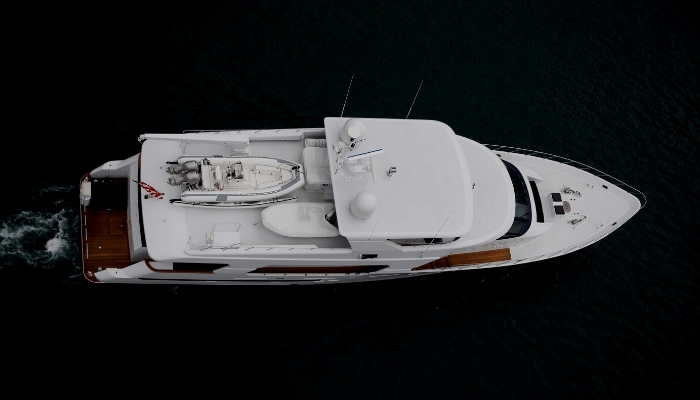
Registered at the Port of George Town and sailing under the Cayman Islands Flag, Sarha is a 40 m motor yacht built by Sea Management, fabricated in Australia and launched in 1989. With its sleek white exterior and blue windows, she is a piece of sheer beauty and class.
She was designed by John Winterbotham & Partners while her interiors were done by H2 Yacht Design. Refitted in 2002, she boasts a steel hull and an aluminium and steel superstructure complemented by a fine teak deck with spacious seating areas.
Sarha can travel 3000 nautical miles at a cruising speed of 10 knots, and her top speed is 13 knots. She is fitted with two 2340 HP diesel engines that generate 1722 kilowatts. She is driven by two propellers and Koopnautic thrusters. Her home port is Abu Dhabi, and her water tanks carry 20,000 litres of fresh water.
Sarha can accommodate 30 guests and 11 crew members in beautiful, well-ventilated cabins having double beds. She has a gross tonnage of 726 tonnes and a 500-tonne displacement. Having a wide beam of 12.9 m, she has a shallow draft of about 2.7 metres.
7. Royal Falcon One ( 135 Ft.)
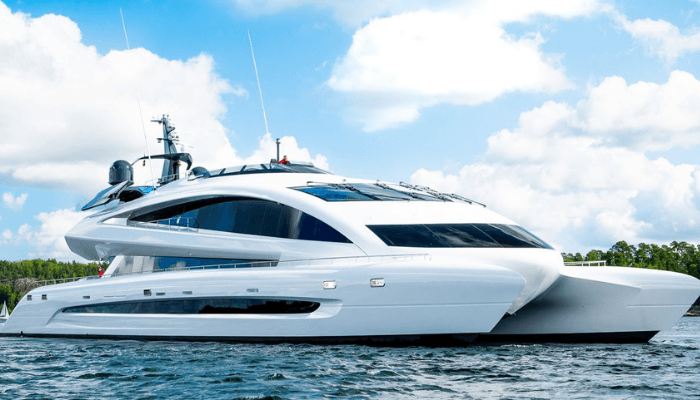
Flaunting a modern naval design, Royal Falcon One is a stunner of the Singapore-based yacht builder, Royal Falcon Fleet. Curated by the renowned Porsche Design Studio, she has been described as a Spaceship on Water by her makers, while some compare her to a sports car. She has an aluminium hull and superstructure and three teak decks.
Enriched with appealing aesthetics, this dual-hulled yacht offers the highest comfort and luxury. She has five cabins to accommodate 10 guests, three master suites and a lounge on the main deck. Its main attraction is the saloon which offers a 360-degree ocean view due to its glass walls.
The 12.5 m broad beam allows for more entertainment and relaxation space. Its sundeck has a jacuzzi and a steam sauna. The crew cabins are located near the stern, concealed by the ship’s twin hulls. Delivered in 2019, it has a maximum speed of 35 knots, a 1.7 m draft and a gross tonnage of 499 tonnes.
8. Silver Cloud (134 Ft.)
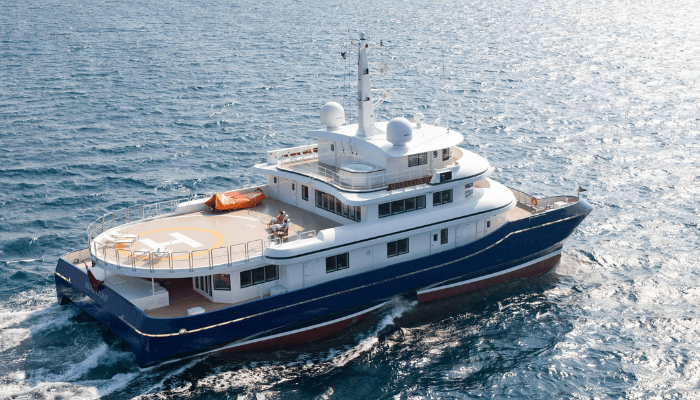
Portraying exemplary marine engineering , Silver Cloud was constructed by Abeking & Rasmussen in Germany. Infused with a small waterplane area twin hull, commonly called SWATH, its distinguishing feature is smooth sailing in harsh waters, especially the North Sea.
It was sold for 16 million dollars to Alexander Wallace Dreyfoos Junior, an American businessman based in New York. As per news reports, the vessel will be renamed Nurja. With a 58 feet beam and a 13.5-foot draft, she has a maximum speed of 14 knots.
Silver Cloud is the two-time winner of the World Superyacht Award, owing to its highly trained crew and world-class reputation. It has five cabins that comfortably sleep 12 guests, equipped with televisions and private bathrooms. The main attraction is the saloon with large windows and glass doors, designed by Michael Kirschstein. It also contains a spa, gymnasium, diving equipment and a helipad.
9. Zenith ( 131 Feet)
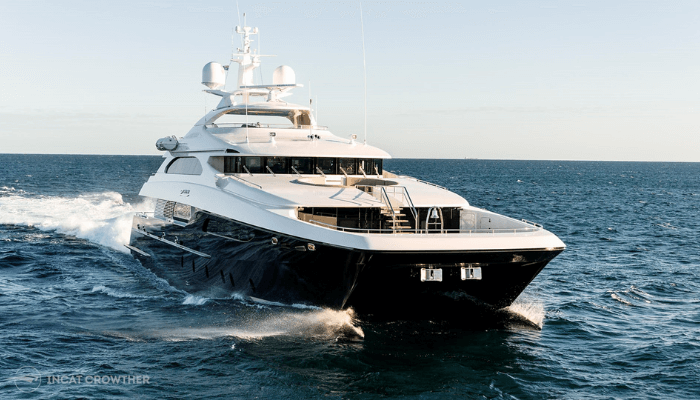
Constructed by Australia-based Sabre Catamarans in 2012, the 40.5 m Zenith is a luxury motor yacht which redefines sophistication and style. She has a 10.5 m beam, a 1.5 m draft and an interior volume of 461 gross tonnes. She was sold in 2018 for a whopping 19 million dollars.
Her luxurious cabins can take in 10 guests, designed by Water Line, while her eye-catching exteriors were chosen by Incat Crowther. Having an aluminium hull and superstructure, she can attain a top speed of 29 knots due to the powerful MTU engines. Her fuel tanks can hold up to 51,800 litres of diesel, while freshwater tanks can carry 3790 litres.
American rock maple was used for interior panelling along with Queensland Maple. It has a spacious open lounge with four sofas. The main deck features a lavish dining area attached to a fully equipped media room and a cocktail bar.
10. The Beast ( 129 Ft.)
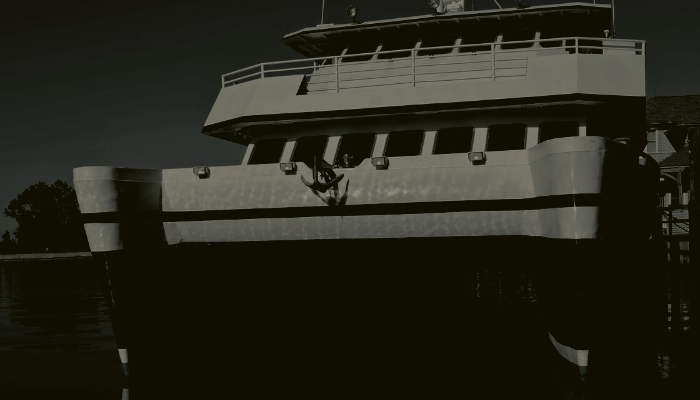
Described as somewhat different and unique by her owners, the Beast is true to its name. Having a military-type camouflage exterior, she is not easy to spot among other sailing vessels. She belongs to the entrepreneur, Sir Michael Hill and has several interesting features, the first being a 13 m fishing boat fitted on its main deck, known as Baby beast.
Winner of several awards, the Beast is 39.2 metres long and has a volume of 493 gross tonnes. She was delivered in 2019 by Profab Central Engineering Limited, and her decor was styled by the famous Oceania Interiors. She has a master suite and five cabins for sleeping 12 guests and accommodation for nine crew members.
Known for her outstanding seagoing capabilities, the Beast is available for charter in the South Pacific. Having a steel hull and aluminium superstructure, she is loaded with the latest water gear such as four kayaks, paddleboards, and fishing and diving equipment. She can reach a top speed of 15 knots while her cruising speed is 10 knots.
You might also like to read:
- Top 10 Biggest RoRo Ships In The World
- 5 Biggest Tanker Ships In the World
- 5 Biggest and Magnificent Sailing Ships of All Time
- 10 Most Expensive Cruise Ships
- Top 10 Biggest LNG Ships

About Author
Zahra is an alumna of Miranda House, University of Delhi. She is an avid writer, possessing immaculate research and editing skills. Author of several academic papers, she has also worked as a freelance writer, producing many technical, creative and marketing pieces. A true aesthete at heart, she loves books a little more than anything else.
Read More Articles By This Author >
Disclaimer : The information contained in this website is for general information purposes only. While we endeavour to keep the information up to date and correct, we make no representations or warranties of any kind, express or implied, about the completeness, accuracy, reliability, suitability or availability with respect to the website or the information, products, services, or related graphics contained on the website for any purpose. Any reliance you place on such information is therefore strictly at your own risk.
In no event will we be liable for any loss or damage including without limitation, indirect or consequential loss or damage, or any loss or damage whatsoever arising from loss of data or profits arising out of, or in connection with, the use of this website.
Do you have info to share with us ? Suggest a correction
Related Articles

The National Maritime Centre: Providing Quality with Utility
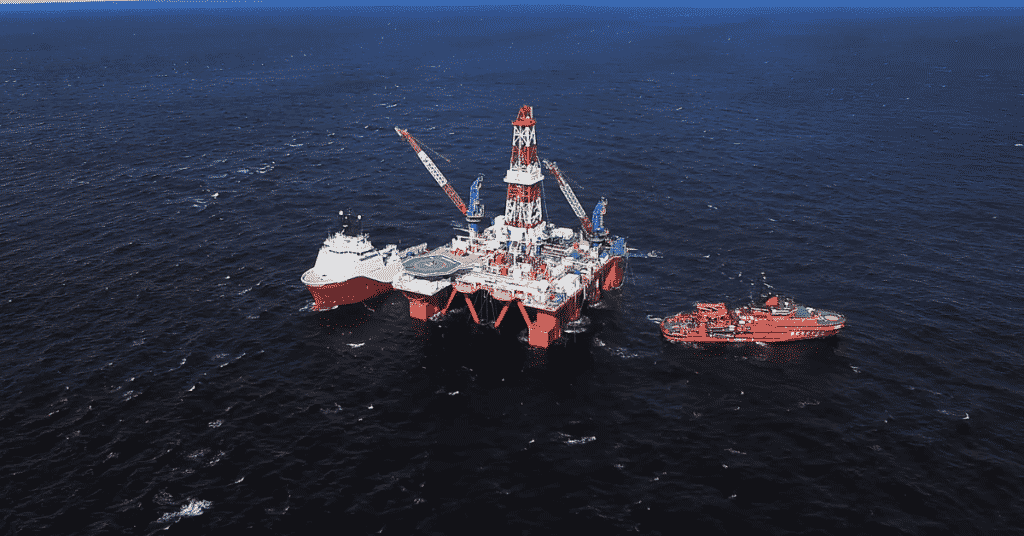
Subsea Drilling: The What, Why and How
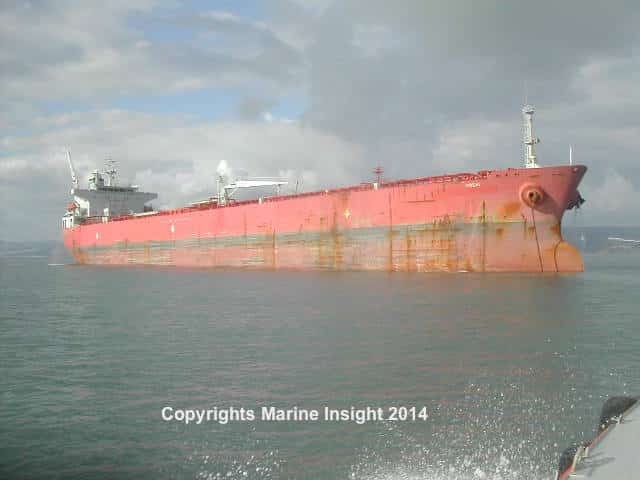
The Institute of Chartered Shipbrokers (ICS) Exams and What they Mean to an Average Shippy
Daily maritime news, straight to your inbox.
Sign Up To Get Daily Newsletters
Join over 60k+ people who read our daily newsletters
By subscribing, you agree to our Privacy Policy and may receive occasional deal communications; you can unsubscribe anytime.
BE THE FIRST TO COMMENT
Leave a reply.
Your email address will not be published. Required fields are marked *
Subscribe to Marine Insight Daily Newsletter
" * " indicates required fields
Marine Engineering
Marine Engine Air Compressor Marine Boiler Oily Water Separator Marine Electrical Ship Generator Ship Stabilizer
Nautical Science
Mooring Bridge Watchkeeping Ship Manoeuvring Nautical Charts Anchoring Nautical Equipment Shipboard Guidelines
Explore
Free Maritime eBooks Premium Maritime eBooks Marine Safety Financial Planning Marine Careers Maritime Law Ship Dry Dock
Shipping News Maritime Reports Videos Maritime Piracy Offshore Safety Of Life At Sea (SOLAS) MARPOL
WAIT! Did You Download 13 FREE Maritime eBooks?
Sign-up and download instantly!
We respect your privacy and take protecting it very seriously. No spam!
WAIT! Did You Download 12 FREE Maritime eBooks?

How To Sail a Large Catamaran (Complete Guide)
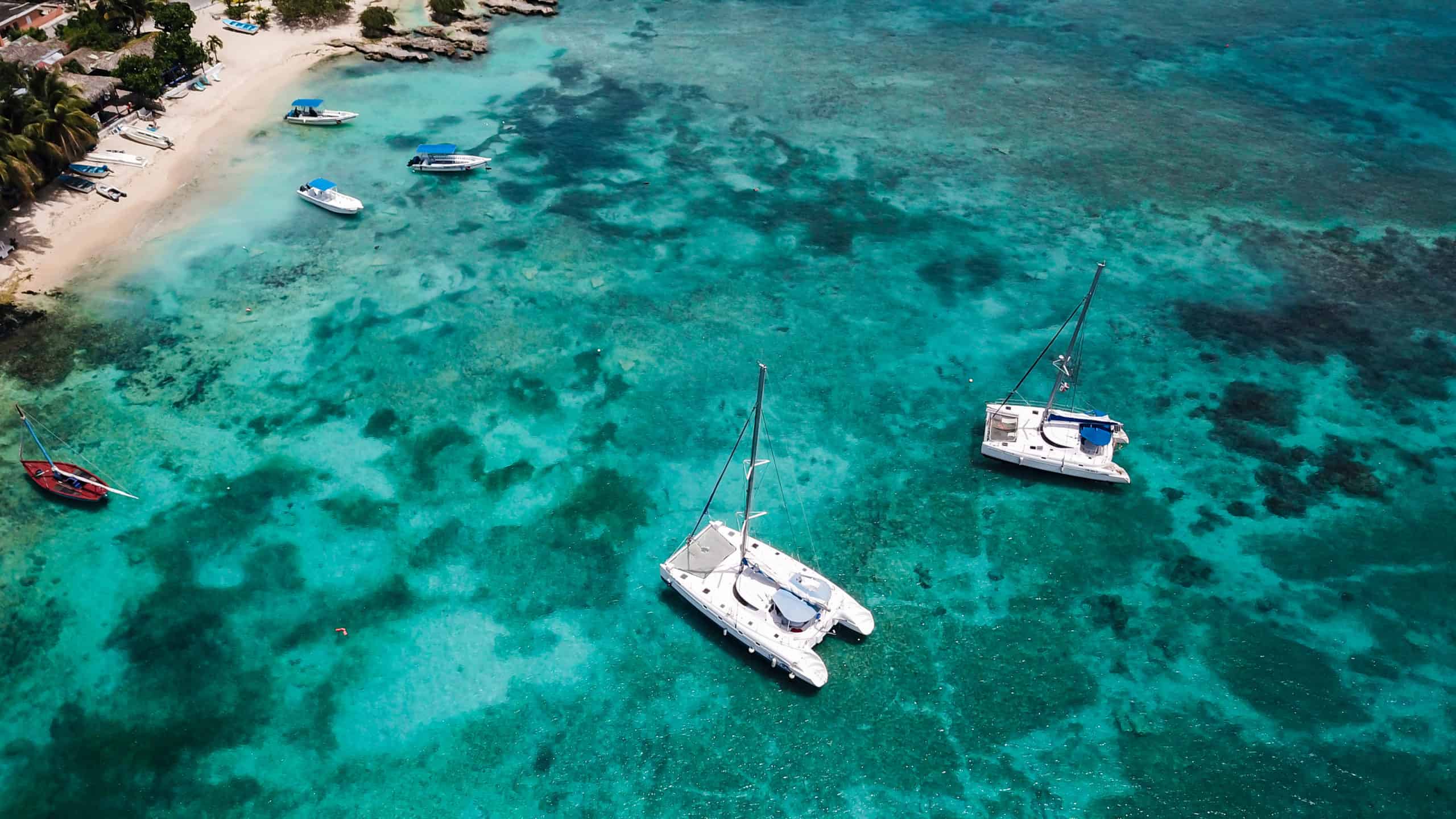
As an Amazon Associate, we earn from qualifying purchases. We may also earn commissions if you purchase products from other retailers after clicking on a link from our site.
Over the years, catamarans have evolved from small boats to large cruisers capable of carrying thousands of people and tons of cargo. They have become increasingly popular because of their large carrying capacity, high speeds, and increased stability. If you are interested in learning how to sail a large catamaran, you are in the right place.
To sail a large catamaran like a professional, you first need to familiarize yourself with its different parts and commonly used sailing terms. Prepare for sailing by rigging and maneuver the waters by carefully tacking and jibing where necessary. Additionally, you will need to know about docking.
For mastery of catamaran sailing skills, you can enroll in sailing classes, watch as an expert sail, or watch YouTube tutorials. Additionally, you can use this piece, which offers a complete guide on sailing a catamaran. Read on to learn more about:
- What is a catamaran
- Parts of a catamaran
- Important sailing terms
- Catamaran sailing guide
Read this for some surprising and cheap ways of learning to sail a catamaran!
Table of Contents
Know the Essential Parts of a Catamaran and Important Sailing Terms
Before you learn how to sail, you need to understand what a catamaran is and its structure. Knowing the key parts of a catamaran is crucial if you are interested in sailing a cat because, other than expounding your knowledge, it helps with communication when sailing.
What Is a Catamaran?
A catamaran, also known as a cat, is a multi-hulled large sailboat . It features two engines and two equally sized parallel hulls connected by crossbeams from which it derives its stability. It boasts of a vast space that contributes to its large carrying capacity.
Essential Parts of a Catamaran
Below are some of the vital parts of a catamaran:
- Hull : The body of the catamaran that carries cargo and passengers and also supports rigging.
- Keel : usually mini keels that are attached below the hull to prevent the cat from sliding sideways. It provides stability and reduces the chances of capsizing .
- Rudder : A movable underwater steering part of the cat that is turned by a tiller or steering wheel.
- Mast : A robust vertical pole whose primary role is supporting sails.
- Mainsail : The principal triangular sail on the mast, which is also the most important sail.
- Headsail : Also known as the jib. It is the foresail that fits the foretriangle in the mast.
- Boom: A pole that is horizontally attached to the mast mainly used for extending the foot of the mainsail.
- Sheets : Strong ropes used to control the sail’s angle in relation to the wind.
- Halyard : They are ropes used to raise or lower the sails on the mast.
- Winch : A cylindrical or drum-shaped metallic device on which lines are wrapped for easier trimming.
- Rigging : is everything that makes the sail function in the correct way. There are two types of rigging:
- The running rigging: Refers to rigging used to operate the sails. For example, the halyard lowers and heaves the mainsail.
- The standing rigging: The rigging that supports the mast and the sail to keep it upright.
Complete interactive guide to catamaran parts!
Now that you are familiar with some parts of a catamaran let’s look at the important sailing terminologies.
Important Sailing Terms
These important sailing terms will come in handy when sailing:
- Port: When facing forward, port refers to anything to the left of the catamaran. You can use this term when referring to the left side.
- Starboard : It is the opposite of ‘port.’ It refers to anything to the right of the cat.
- Point of sail : This refers to the cat’s direction relative to the wind. For example, if the wind blows straight over the sides of your cat, you are on a ‘beam reach’ point of sail. Additionally, if you are heading straight to the wind (which is not advisable), you are on the ‘in irons’ point of sail.
- Bow/stern : Refers to the front and back parts of the catamaran, respectively. Anything to the front is said to be in the ‘forward’ / ‘Abaft’ while the back is in the ‘aft.’
- Heeling: A situation in which the catamaran leans over in the water while being pushed by the wind.
- Windward : It is the side of the cat that is closest to the wind. When heeling, the windward side is often the highest.
- Leeward : The side of your cat furthest from the wind. It is often the lowest side when heeling.
- Tack: Tack has two distinct meanings as a verb and as a noun. As a verb, it means changing direction by turning the catamaran’s bow through the wind. On the other hand, it means your cat’s course relative to the wind as a noun. For example, if the wind is blowing on the port side, you will say you are on the port tack.
- Jibe (Gybe) : It is another way of changing direction, in which case you bring the stern through the wind.
Complete parts guide if you want to know more!
With the above terms in mind, you are now better positioned to understand how to sail a catamaran.
Understand How a Catamaran Works
A catamaran works similarly to any other monohull sailboat. However, many people, and especially newbies, do not clearly understand the concept behind the forward motion. Here is how it works:
Once in the water, the wind blows over the sails creating high pressure on one side and low pressure on the opposite side. These two opposite pressures create a forward force. As the wind continues to blow, it forms a pulling force that works on your cat, making it move. And because your cat has keels under the hull, they help it to move forward and not slide to the side as much.
Your control of the steering wheel, plus the pressure of the wind, keep your cat moving in your desired direction. This means you do not just sit back and wait for the wind to heel your cat. You, too, have control over it.
Prepare Your Catamaran for Sailing
The state of your catamaran and the weather conditions affect sailing. Therefore, it’s important to prepare and assess the weather conditions before you set out.
To prepare your catamaran for sailing:
Perform a Detailed Check
Visually check your cat to ensure all parts are intact and in perfect working condition. Here are a few things to do:
- Check your standing and running rigging for cracks or excessive wear.
- Ensure that the lines are free; that is, they are not wrapped around each other or folded on to anything else within the cat. Pull the lines off the cleats (on-deck hooks) and off the winches to ensure they are free of any obstacles.
- Additionally, check if the tiller is properly attached to the rudder. Also, ensure that it efficiently controls the rudder.
- Check the condition of your sails. They should be straight with no frayed edges or wrinkles. At this point, your cat is ready for you to hoist the sails.
Determine the Wind’s Direction
Use the wind instruments on your cat to check the direction of the wind. Most cats have a wind indicator on their mast or a digital gauge.
Additionally, you can determine the wind’s direction using the flags attached to the sides of your cat.
Point the Catamaran to the Wind
Having known the direction of the wind, now point your cat in the right direction using your engines to move you into place. The idea here is to have minimum wind resistance when raising the sails.
Hoist the Sails
After preparing your cat, the next step is to hoist the sails. To do this:
Attach the Sails
To hoist the sails, start with the mainsail.
- Prepare your mainsail for hoisting; open the easy-bag (a zip bag that stores the mainsail). Before releasing the mainsail, ensure that everything is clear to allow it to pass between the lazy jacks (riggings along each side of the mainsail that extends from the boom o a point on the mast) with ease.
- Locate the main halyard (rope used to raise or lower the mainsail) in your cat and begin raising the mainsail. If you have enough manpower, you can begin pulling it by hand (wear a pair of hand gloves or use a winch for this). Pull it until it is perfectly positioned on the mast. Your mainsail is now hoisted. Allow it to fill with air.
- Next, correctly coil the main halyard so that the mainsail can be lowered quickly and with much ease if need be.
- Now we move on to the headsail/jib/genoa. Hoisting the jib is much easier compared to hoisting the mainsail. Identify the jib halyard (rope used to raise or lower the jib) in your cat. Just like the mainsail, ensure the jib is free, and the reefing lines are clear.
- Start pulling the jib halyard until the jib is correctly positioned. You can pull it by hand or using the winch. Coil your jib halyard correctly.
- Your sails are now positioned, and you are ready to sail. Be sure to trim them according to changes in the wind’s direction.
Adjust Your Direction and Sail Trim
Always remember it is not possible to sail your cat directly into the wind. You can change your direction through tacking or jibing.
When heeling, a heel greater than 10° is an indication that the wind is overpowering you, and your windward hull will be close to lifting. In this case, consider releasing the main sheets briefly to reduce the heel. A comfortable heeling position is between 6-7°.
Trim the Jib Sheets
Despite the mainsail being hoisted first, the jib comes first when trimming. Of the two jib sheets on the catamaran’s sides, start by pulling the one on the leeward. The leeward sheet is known as the active sheet, and the lazy sheet is the one opposite.
The jib sheet forms a curve as you trim, and it’s up to you to trim it until its front edge stops luffing.
Trim the Mainsail
Trimming the mainsail is easy. Pull out the main sheet. Once the mainsail’s front edge starts luffing, draw it back until the luffing stops.
If the direction remains constant, this position is ideal to set your sails. If the wind direction changes, adjust the sheet appropriately. At this point, you are more than ready to sail.
Sail Your Catamaran
Watch your sails.
Keep an eye on the sail edge’s front on the jib and the mainsail. If you notice any luffing on your sails, you have a couple of options. To either tighten the main sheets to stop the luffing or direct the cat away from the wind (bearing off). At this point, luffing indicates that you are going much deeper into the wind’s direction.
Watch Out for Your Telltale
Telltales are the wind indicators that notify you of any changes in the wind direction on your sails. Your telltales will help you know whether your sail trim is correct. They help you determine how you should adjust your sails to get the maximum forward momentum.
Different Points of Sail
Broad reach.
A broad reach is when you have the wind blowing at your back and side.
It’s the most efficient sailing position when going downwind because both sails will be filled with wind, thus moving you at maximum force.
Running is when the wind is blowing at your back. This is not a good sailing position. It is risky because the plenty of air moving over the sail generates more force than the wind pushing the cat. To avoid this, pull the jib sheet over to the opposite side to create a wing-on-wing position. This helps in reducing the force on the sail.
Note : When your cat is running, it’s possible that the force of the wind behind it can cause a sudden jibe (gybe). This sudden change of direction can throw the boom to the cockpit with a huge force that can knock you down. Be careful when on a running course.
Therefore, it is advisable to use a rig preventer (a line from the boom to any available cleat) when running the wind. The rig preventer helps in preventing accidents in case of a sudden jibe.
Close Reach
For a close reach point of sail, turn your cat slightly so that your heading is approximately 60-75° off the wind. Here you need to trim the sheets further to ensure that the sheets are more aligned with the body of your cat.
This is considered the most precise point of sail. To achieve this, you will turn your cat to about 90° of the wind. The sails are let out halfway, and at this point, your cat can offer you some really good speeds.
Close haul offers you a position in which you can sail as close as possible to the wind. It is about 45-60° off the wind. On a catamaran, especially a heavily loaded cruising catamaran this number is higher(not able to sail close to the wind), and on a performance cat, you can go a little closer to the wind.
Sail Upwind
When shifting to a close haul tack, sheet in the sails as you fully lower the centerboards or daggerboards. Continue steering as you observe the telltales and other wind indicators, being cautious not to pinch (sail too close to the wind).
Sailing Downwind
Under light or moderate winds, catamarans sail fast downwind.
Changing direction
If you want to sail in another direction, you can change your bearing through tacking or jibing. However, tacking is more popular among sailors than jibing.
For you to tack under moderate conditions, you must be sailing as close-hauled as possible. Additionally, you should center the traveler (a great sail-control used in fine-tuning the mainsail).
Based on the prevailing sea state, it might be necessary to briefly backwind the jibsail before sheeting in on the new direction. This will help the bow in making a successful turn through the wind.
For a successful tack, you should be quick in sheeting in the jibsail in the new direction. If you feel like your cat is going to stall, quickly release the traveler and the mainsheet as they will force the bow through the wind.
During this time, you should continue with the helm (tiller and other parts associated with the steering wheel) and steer all the way through the wind.
The rudder angle and the wind indicators will help you know when the tack has been completed, which prompts you to straighten the rudders. Your cat is now on a new tack.
Tacking vs Jibing explained
By jibing, you turn the cat away (bear away) from the wind by bringing the stern across the wind.
To begin with, centralize the traveler to allow for the mainsail to be centered. Before you start turning, sheet in the mainsheet hard so that when you bear away, your mainsail wont be swinging around and risk injury to equipment or crew.
Once the mainsail has back winded and changed direction so that you are on the opposite tack, quickly release the mainsheet to ensure that the power remains on as you prepare for the second part of the jibe.
Now back wind the jibsail and quickly release the windward jib sheet. Do this as you tighten the leeward jib sheet until the jibsail passes through the fore triangle and you can easily trim it using this same jib sheet. Release the windward jib sheet completely.
Sailing Safety
When learning how to sail a catamaran, it is also important to gain some tips on reefing , which is one of the most important sailing safety tips. Additionally, you should learn when your catamaran is in danger of capsizing.
Docking Your Catamaran
The way you dock in your catamaran depends on the side with which you are approaching the dock. For example, when docking to portside, your first part ashore will be the spring line leading forward from your port quarter (left rear part of your boat).
Once you arrive at the dock, put the port engine in slow reverse and the starboard one in forward mode. The different engine modes will help you place your catamaran close to the dock while allowing your spring line to be securely held and tightened. The spring line is the rope you tie to the dock from your catamaran to prevent the boat’s forward and backward movement.
Tightening the spring line helps hold you close and steady as you secure the bow and stern lines.
Consistency and practice will help you grasp large catamaran sailing concepts much faster.
Here’s a summary of the tips to help you in this course:
- Familiarize yourself with parts of a catamaran before getting into the water.
- Learn common sailing terms.
- Learn how to prepare your catamaran through visual checks of rigging sails.
- Practice hoisting and trimming the mainsail and the headsail.
- Conquer your fears and face the actual challenge of sailing a catamaran. Be confident, practice consistently, and you will sail like a professional sooner than you expect.
- Catamaran Parts Explained
- Tacking vs Jibing?
- Cruising World: How to Dock and Swing a Catamaran
Owner of CatamaranFreedom.com. A minimalist that has lived in a caravan in Sweden, 35ft Monohull in the Bahamas, and right now in his self-built Van. He just started the next adventure, to circumnavigate the world on a Catamaran!
Leave a Reply Cancel reply
Your email address will not be published. Required fields are marked *
Save my name and email in this browser for the next time I comment.
Recent Posts
Must-Have Boat Gear for Catamaran Sailors!
Sailing is probably the most gear-intensive activity I've ever done; there are so many decisions to be made about what gear to buy now, for tomorrow, and what to definitely never buy. The gear on...
6 Best Trailerable Trimarans For Bluewater and Coastal Sailing
Having a boat costs a lot of money, even when you are not using it, marina fees, etc. And once it is in the water most sailors never go very far from their "home marina" and sailing will be somewhat...

- European Union
- South Africa
- Photos & Videos
Virtual Tour
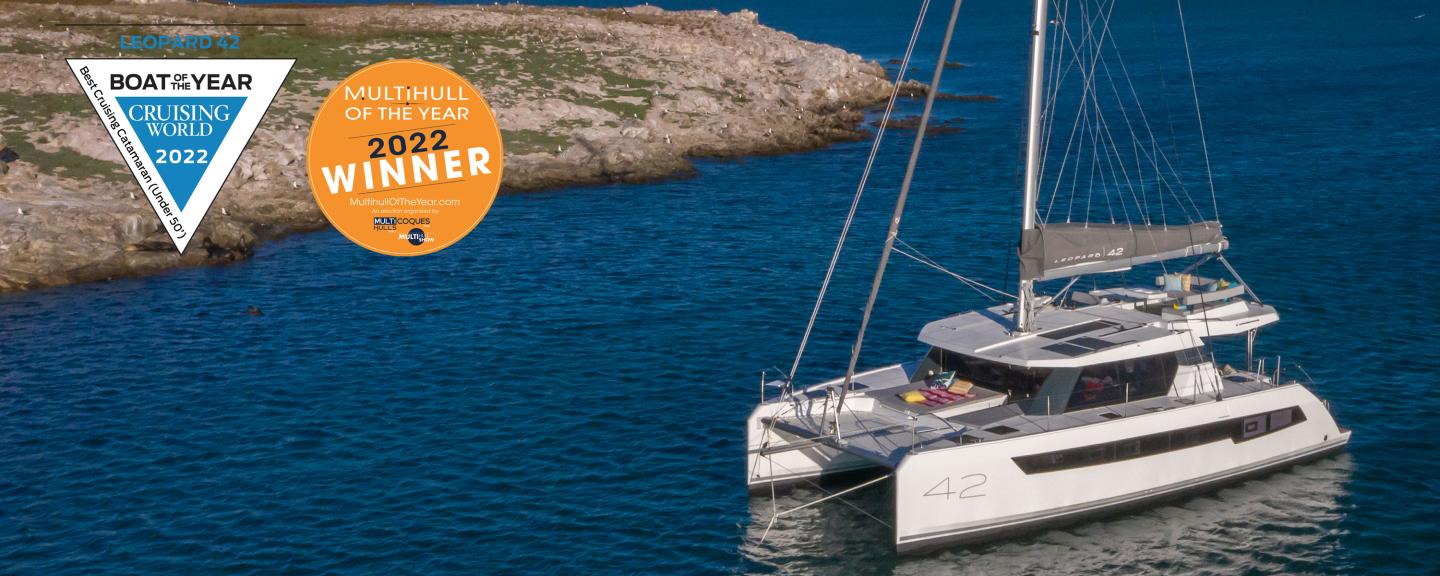
- Cabins: 3 or 4
- Heads: 3 or 4
- Berths: 6 or 8
- Showers: 3 or 4 (plus transom)
Your journey, uncompromised Built by Robertson & Caine and designed by naval architects Simonis Voogd, the Leopard 42 utilizes superior finishes and materials, creating a one-of-a-kind vessel that balances comfort, performance and ease of handling. A thoughtful design process ensures every feature and function has been anticipated, with minimal customization needed. Those onboard can move about effortlessly knowing their needs are fully addressed in every aspect of the Leopard 42. The exterior’s striking design features continuous hull side windows, a continuous hardtop, and Leopard Catamaran’s signature upper-lounge area. Like the Leopard 50, the Leopard 42’s subtle elegance is accented by modern design elements and classic finishes without losing the rugged spirit and sportive quality for which Leopard is known. A handsome interior reveals generous natural light from optimized window placements including an additional window in the aft starboard corner facing the helm seat and a skylight in the saloon. Preparing meals no longer feels like an afterthought with a forward-facing, L-shaped galley that invites everyone to participate in the process. The Leopard 42 reimagines comfort through its optimal use of space and attention to detail. All bunks are now island berths that allow access from both sides. Available in three cabin/three heads and four cabin/four heads, all cabins include private ensuite heads. All heads also include their own designated shower area, a feature not currently found on catamarans in this size range. Equal parts luxury and performance, the Leopard 42’s capabilities far exceed its size. Together with new technology and building techniques, the Leopard 42 brings exhilaration and freedom to sailing in a way no other sailboat can. Always reaching new destinations, the Leopard 42 is ready for your next adventure.
SPECIAL OFFER


- LOA: 41 ft 7 in / 12.67 m
- LWL: 40 ft 10 in / 12.44 m
- Beam: 23 ft 1 in / 7.04 m
- Draft: 4 ft 7 in / 1.4 m
- Mast Height: 67 ft 10 in / 20.68 m
- Bridgedeck Clearance: 2 ft 6 in / 0.75 m
- Engine: 2 x Yanmar 45HP Diesel engine with saildrive
- Fuel: 158 gal / 600 L
EXTRA DETAILS
- Bunk Dimensions: View Leopard Range Bunk Dimensions
- Headroom: View Leopard Range Headroom Dimensions
- Water: 174 gal / 660 L
- Mainsail Area (Standard): 717 sqft / 66.6 sqm
- Mainsail Area (Square Top): 755 sqft / 70.1 sqm
- Genoa Area: 501 sqft / 46.5 sqm
- Spinnaker Area: 1686 sqft / 156.6 sqm
- Code 0 Area: 676 sqft / 62.8 sqm
- Code D Area: 1022 sqft / 94.9 sqm
- Total Upwind Area (Standard): 1217 sqft / 113.1 sqm
- Polars: View Leopard 42 Performance Documents
- Displacement: 30183 lbs / 13691 kg
- Load Carrying Capacity: 11056 lbs / 5015 kg
- Holding Tank Capacity: 44 gal / 166 L
All Leopard Catamarans are NMMA and CE Certified.
DOWNLOAD BROCHURE
Related Boat Reviews
Leopard catamarans feature - passagemaker, cruising world magazine - leopard 42 review, multihull sailor magazine - leopard 42 review.
Make an appointment for a boat show, a sea trial, or simply receive a phone call from our expert agents.
Other Leopard 42 Buying Options
Check for current availability of used Leopard Catamarans and new Leopard Catamarans in charter programs on our sister sites

What Size Catamaran To Sail Around The World

Last Updated by
Daniel Wade
August 30, 2022
Catamarans are generally longer than monohulls, but their accommodations and handling vary widely between sizes.
The best size catamaran to sail around the world is 45 to 50 feet. The smallest catamaran with space for long-term provisions and a cabin is around 30 feet in length, and a 55 to 60-foot catamaran is the largest that can be accommodated at most marinas.
In this article, we'll go over the different sizes of catamarans and how they handle in the open ocean. Additionally, we'll cover each size category and the best sizes for traveling the Pacific and Atlantic Oceans.
We sourced the information used in this article from marine design guides and the consensus of experienced catamaran sailors.
Table of contents
What Sizes Are Catamarans?
Catamarans come in all shapes and sizes, but the smallest models don't have the accommodations required to sail around the world. Most catamarans under 30 feet in length don't have a cabin at all, which is a stark difference that they have with monohulls.
Small monohull sailboats often have cabins, as there's plenty of room below on a wide single-hulled sailboat. Monohulls can be as small as 16 to 18 feet and still have a cabin, but catamarans must be much larger to have suitable accommodations.
The smallest catamarans are about 12 to 15 feet long. These are small recreational craft used primarily for racing, and they aren't designed for the open ocean. Larger catamarans in the 20-foot range can (and have) been used on the ocean, but they're usually classified as day boats.
Catamarans become practical for longer excursions once they hit about 30 feet in length. A boat of this size is large enough for a cabin and can usually accommodate between two and four people comfortably. Catamarans commonly stretch beyond 50 feet, which is where they're the most useful and comfortable.
Smallest Catamaran to Sail Around the World
So, what's the smallest catamaran you could use to sail around the world? In theory, any catamaran can sail long distances—but you need one that's large enough for shelter and storing provisions. Generally speaking, 30 feet is the bottom limit for an ocean-crossing catamaran.
Let's take the ME Cat 30 (Maine Cat) as an example. This small and nimble 30-foot catamaran makes use of its limited space and provides comfortable accommodations for a few adults. The ME Cat 30 is a split design that houses the basic accommodations in either hull, with an open seating area between them.
Inside the ME Cat 30, there's barely enough room for all the living spaces. It features a head and a large bed in one hull and a galley and a smaller berth in the other. With that, all the useful cabin space is filled—and this is considered a very good design for the size. As you can see, the best catamarans for sailing across the world are usually much larger.
Typical Ocean Crossing Catamaran Size
Based on what we discussed above, a 30-foot cruising catamaran is really pushing the limits on size. However, it doesn't take a whole lot more length to make a catamaran exponentially more comfortable and suitable for long journeys.
The typical ocean-crossing catamaran is usually about 40 to 45 feet long. With the addition of 10 feet in length, designers can fit an enormous amount of additional accommodations in the hulls.
This is because adding a little extra length allows designers and boatbuilders to widen each hull significantly, which makes room for luxuries like private bedrooms, multiple bathrooms, and entirely separate dining and cooking spaces.
Cruising Catamaran Floor Plans
A 40-foot to 50-foot catamaran usually comes with a mirrored floor plan. The traditional catamaran has an identical layout in each hull. That means if one hull has a private berth in the bow and a shower and a toilet in the stern, the other hull will have the exact same layout except opposite.
This is usually because spaces like the galley and sitting area are kept in the center console, where there's much more space to move around. Spaces that are used at night or only occasionally are kept in the narrow hulls, as this has proven to be a more comfortable layout for crews.
Storage is usually kept deep in the hulls as well, as there's extra space to work with when the only other design purpose is for sleeping in bathing. Catamarans in this size range can also have separate hull layouts, but the mirrored design is by far the most common.
Best Catamaran Size for Pacific Ocean Cruising
Catamarans are very versatile craft, but some function better in the Pacific Ocean than others. One of the main considerations when choosing a catamaran for Pacific Travel is that the Pacific usually has greater distances between ports and stopping points.
This is especially true on the US West Coast, where there are only a handful of ports and safe anchorages. The best Pacific cruising catamaran size is between 45 and 50 feet in length, as you're likely to need more space to store provisions for extended cruising.
If you're starting in San Francisco or Seattle, even a 'short' trip along the coastline could mean you'll pass hundreds of miles of steep rocky cliffs and no stopping points insight. When crossing the Pacific, you may travel thousands of miles before you encounter a port or island with any infrastructure at all, let alone stocks of provisions and a full-service marina.
The Pacific is a huge ocean, and the last thing you want to do is run out of food or fuel a thousand miles from your destination. Larger boats store more supplies, and they also give you more breathing room when you're surrounded by empty blue water for months on end.
Best Catamaran Size for Atlantic Ocean Cruising
The Atlantic Ocean is smaller than the Pacific Ocean, and the coastlines of many countries that border it tend to be well-developed. This makes it easier to get away with owning a smaller boat, as you don't need to store as many supplies, and your voyages will be shorter.
Another factor to consider is that not all marinas on the Atlantic can accommodate extremely large catamarans, or it may be prohibitively expensive to dock a 55-foot or 60-foot double-wide vessel. That's why the ideal size for an Atlantic-crossing catamaran is between 40 feet and 50 feet. Today, 45 feet seems to be average.
The boat of this size will fit in at most marinas in developed countries around the Atlantic, and its draft is shallow enough for island hopping and exploring the coral reefs that the Atlantic Islands are known for. Additionally, 40 to 50-foot catamarans are usually just as seaworthy as the larger boats, and they're less expensive to maintain.
Unlike the US West Coast, where ports are few and far between, the Atlantic in the Gulf of Mexico is littered with marinas and safe anchorages. You can travel for weeks along the coastline of the United States and parts of South America and never be further than a hundred miles from a full-service marina.
There are also hundreds of islands, tourist destinations, and service locations that reduce your need for large stores of provisions aboard your catamaran. This gives you a lot more flexibility in choosing a size and a floor plan, as your needs are different than that of a Pacific sailor.
Best Catamaran Size for World Cruising
If you're planning to go on a world tour or a circumnavigation, you're going to need a catamaran that's large enough to fit your crew and your provisions comfortably.
You'll also need a boat that is small enough to be serviced and accommodated in most locations but also seaworthy enough to whether anything you're likely to encounter out of the water.
For most people, the sweet spot seems to be around 45 to 50 feet in length. A 50-foot catamaran is more than large enough to store enough provisions for many months of sailing. It's also roomy enough to house two to six people comfortably for many weeks at a time.
Catamarans between 40 and 50 feet in length are also extremely seaworthy and have been known to make circumnavigation frequently. You're almost guaranteed to find a 50-foot catamaran in almost any remote anchorage in the world where sailors are known to frequent.
Also, almost any marina can accommodate a 50-foot catamaran, and most boatyards can perform at least basic repairs on a boat of this size. Most marinas have fee schedules for boats based on size, and the cutoff for large boats is usually 60 feet. This keeps you in the 'medium' boat category, which can save you thousands.
How to Choose a Catamaran Size
Choosing the right size catamaran can be challenging, but there are a few things you can do to narrow it down. First, examine how you plan to use the vessel. You can travel the oceans in a catamaran between 30 and 40 feet long, so if you have a small crew, you may want to consider a compact model.
Larger catamarans can sleep eight or more people comfortably. This is large enough for most people, though some charter captains may need additional room. A 40 to 45-foot catamaran is usually large enough for a small family, though a 50-footer would be more comfortable, especially if there are kids running around.
Related Articles
I've personally had thousands of questions about sailing and sailboats over the years. As I learn and experience sailing, and the community, I share the answers that work and make sense to me, here on Life of Sailing.
by this author
Most Recent

What Does "Sailing By The Lee" Mean?
October 3, 2023

The Best Sailing Schools And Programs: Reviews & Ratings
September 26, 2023
Important Legal Info
Lifeofsailing.com is a participant in the Amazon Services LLC Associates Program, an affiliate advertising program designed to provide a means for sites to earn advertising fees by advertising and linking to Amazon. This site also participates in other affiliate programs and is compensated for referring traffic and business to these companies.
Similar Posts

How To Choose The Right Sailing Instructor
August 16, 2023

Cost To Sail Around The World
May 16, 2023

Why Do Catamarans Have Trampolines?
April 17, 2023

Popular Posts

Best Liveaboard Catamaran Sailboats
December 28, 2023

Can a Novice Sail Around the World?
Elizabeth O'Malley
June 15, 2022

4 Best Electric Outboard Motors

How Long Did It Take The Vikings To Sail To England?

10 Best Sailboat Brands (And Why)
December 20, 2023

7 Best Places To Liveaboard A Sailboat
Get the best sailing content.
Top Rated Posts
Lifeofsailing.com is a participant in the Amazon Services LLC Associates Program, an affiliate advertising program designed to provide a means for sites to earn advertising fees by advertising and linking to Amazon. This site also participates in other affiliate programs and is compensated for referring traffic and business to these companies. (866) 342-SAIL
© 2024 Life of Sailing Email: [email protected] Address: 11816 Inwood Rd #3024 Dallas, TX 75244 Disclaimer Privacy Policy

Large Catamarans

STEPHEN COCKCROFT / EXCLUSIVE BROKER LARGE CATAMARAN SPECIALIST
Stephen Cockcroft has been sailing since 1975. For more than 25 years, he has influenced and consulted in many aspects of the sailing industry. He is formerly from South Africa where he built his first ocean-going yacht in his backyard. This DIY sailboat project set him on a course to sail it 30,000 NM ending up in the USA where he now resides and is a proud citizen.
Contact Stephen | Phone: 1-804-815-5054 | Skype: stephencockcroft
Looking for a large catamaran for sale?
Catamaran Guru’s team knows the large catamaran market. We are the top catamaran specialists in the industry with over 25 years of experience in all areas of the yachting industry, from small craft to mega yachts and from construction to sailing to brokering.
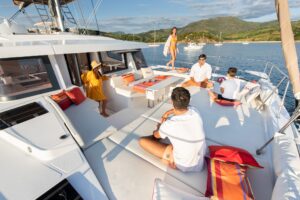
We offer hands-on expertise for most catamaran brands. Our consulting services are comprehensive and at no cost to you, the buyer!
As Independent yacht brokers, Catamaran Guru provides a conduit between buyers of large catamarans and the manufacturers. We provide a platform for the buyer to explore all avenues of the semi-custom, custom or new construction catamaran.
We provide expert advice on all aspects of the buying and building process and we guide the buyer to explore all options to reduce the cost of yacht ownership.
Why Work With Us To Buy A Large Catamaran?
- Acknowledged by the industry as catamaran experts
- Experienced at structuring charter programs to offset the costs of yacht ownership
- Specialists in “ yacht as a business ” models and business set-up
- Proven track record of structuring a business environment which enables owners of large yachts to take advantage of existing tax laws
- Independent large catamaran buying advice at no cost to you.
Our vast experience of the international marine business, technical sailing and catamaran knowledge, financial expertise in yacht buying and selling, global sailboat tax issues and opportunities, and understanding of charter program contractual aspects makes our team the one you would want in your corner representing your interests as a luxury yacht buyer.
We act as your consultant in every aspect of your big catamaran buying experience, from figuring out what you need and want to helping you find the optimal way to purchase and reduce costs to finalizing the transaction.
Crewed Boat Business Program With Income and Tax Advantages
The combination of tax advantages and operating income provide opportunities to not only offset the costs of ownership, but also to create positive net worth through yacht ownership. To learn more about tax advantages and special financing for crewed yacht charters, call us at 804.815.5054 or email us for a consultation .
Crewed Yacht Business Models
- Crewed yachts have a full-time live-aboard crew (Captain and 1st Mate/Chef). The owners can be the crew and run their own boats or can appoint a professional crew
- Crewed boats are flexible as far as location is concerned and can migrate seasonally from Caribbean to New England in the U.S. or to the Mediterranean and back.
- As mentioned before, bookings go through the clearinghouse and they maintain the booking schedule, handle all client needs and funds and liaise with owners and crew.
- Hosts the boat in crewed charter boat shows and do special marketing and advertising
Large Catamaran Brands Available For Luxury Crewed Charter
- Bali 5.4 ; Fountaine Pajot: Saba 50 , FP 59 , and Alegria 67 ; and Lagoon 50 , Lagoon 52 , Lagoon 560 , Lagoon 620 , Lagoon 630MY , Lagoon SIXTY7 MY Lagoon 77 , and Lagoon 78 .
- All Sunreef models
We have access to all these brands and can help you with the finance, purchase, setting up of the business entity and with the management company / booking agents.
Personal Consultation
Our complimentary personal consultation is structured to provide expert advice on how to create your own crewed charter yacht business on a catamaran.
- Your choice may range from a new build production catamaran like Lagoon, Fountaine Pajot, or Sunreef that is available immediately
- Or a customized project that requires a designer, architects, a yard and legal contracts, like a McConaghy Catamaran new build project.
- We assist you in choosing everything from your ultimate dream sailing vessel to components such as layouts, models, equipment choices and charter ownership advice.
- Structuring a crewed charter yacht business and a business plan
- Choice of management companies
- Special crewed charter finance.
Send Stephen Cockcroft a Note Call 804.815.5054
More About Owning Large Catamarans
- Yacht as a business & tax advantages using Section 179
- Large catamarans: How to own and pay for them
- Crewed yacht ownership
- Charter management programs
- Big catamarans in the mainstream
See What Our Clients Say

For more than 30 years, we have been a part of the catamaran community and created Catamaran Guru™ to encourage and educate all the aspiring sailing out there. We understand the dream of traveling the world by catamaran and created a one-stop-shop to make that dream a reality for you.

- Stephen & Estelle
- Testimonials
Get Started
- Yacht Sales
- Used Yachts
- Charter Management
- Boat as Business Programs
- Seminars & Events
Did You Know That We Offer Contract to Closing Services? Click Here to Find Out More.
Need Marine Financing? Apply Here With Our Partner, First Approval Source
- Catamaran Interviews
- Catamaran Reviews
- Buying Advice
- Selling Advice
- Woods Design Advice
- Fastcat 445
- Americat 3014
- Aventura 37
- Balance 526
- Bali 40 Catspace
- Bali Catsmart
- Beneteau Blue II
- Broadblue 346
- Broadblue 38 Prestige
- Broadblue 385
- Broadblue 435
- Broadblue 46
- Catalac 10M
- Catalac 11M
- Catalac 12M
- Catalac 900
- Catana 42 S
- Chris White 48 Voyager
- Chris White 55
- Corsair F28 R
- De Villiers
- Dolphin 460
- Endeavour 30
- Endeavour 35 Victory
- Endeavour 36
- Endeavour 44
- Endeavour 44 TrawlerCat
- Endeavour 50 Pilothouse Trawler
- Fortuna 36 Island Spirit
- Fortuna 401 Island Spirit
- FP 32 Maldives
- FP 35 Tobago
- FP 37 Antigua
- FP 38 Athena
- FP 39 Fidji
- FP 40 Lavezzi
- FP 40 Lucia
- FP 40 Summerland MY
- FP 41 Lipari
- FP 42 Astrea
- FP 42 Venezia
- FP 43 Belize
- FP 44 Helia
- FP 44 Orana
- FP 46 Bahia
- FP 46 Casamance
- FP 48 Salina
- FP 56 Marquises
- FP 57 Sanya
- FP 58 Ipanema
- FP 60 Eleuthera
- FP Saona 47
- Gemini 3000
- Gemini 3200
- Gemini 3400
- Gemini Freestyle 37
- Gemini Freestyle 399 Power
- Gemini Legacy 35
- Grainger 420 Mystery Cove
- Hirondelle 7M
- Lagoon 37 TPI
- Lagoon 42 TPI
- Lagoon 43 PC
- Lagoon Seventy 8
- Leopard 39 PowerCat
- Leopard 45 Classic
- Leopard 47 PowerCat
- Leopard 51 PowerCat
- Leopard 53 PowerCat
- Lidgard 73 Executive
- Maine Cat 30
- Maine Cat 41
- Matrix 450 Vision
- Matrix 760 Silhouette
- Maverick 400
- Maverick 420
- Maverick 440
- Nautitech 40
- Nautitech 442
- Nautitech 46 Open
- Nautitech 47
- Outremer 40
- Outremer 45
- Outremer 50 Standard
- Outremer 55
- Outremer 5X
- Privilege 37
- Privilege 39
- Privilege 42
- Privilege 43
- Privilege 435
- Privilege 45
- Privilege 465
- Privilege 48 Transcat
- Privilege 482
- Privilege 495
- Privilege 510
- Privilege Serie 5
- Prout 31 Quest
- Prout 33 Quest
- Prout 34 Event
- Prout 35 Snowgoose
- Prout 37 Snowgoose
- Prout 37 Snowgoose Elite
- Prout 38 Manta
- Prout 39 Escale
- Royal Cape 45
- Royal Cape 530 Majestic
- Royal Cape Majestic 500
- Sailcraft 30 Iroquois
- Sailcraft 32 Comanche
- Sailcraft 35 Cherokee
- Sailcraft 41 Apache
- Sailcraft 44 Apache
- Wildcat 350
- Seawind 1000
- Seawind 1160
- Seawind 1200
- Seawind 1260
- Seawind 1600
- Solaris 36 Sunrise
- Solaris 36 Sunstar
- St Francis 44
- St Francis 48
- St Francis 50
- Stealth 11.8
- Sunreef 74C
- Sunreef 82 DD
- Sunreef 88 DD
- Heavenly Twins 26
- Ocean Twins 38
- Voyage 380 Maxim
- Voyage 400 Norseman
- Voyage 430 Norseman
- Voyage 450 Cabriolet
- Voyage 47 Mayotte
- Wharram 38 Tiki
- AMI 320 Renaissance
- Woods 22 Wizard
- Woods 35 Banshee
- Woods 35 Flica
- Woods 36 Scylla
- Woods 36 Vardo
- Woods 38 Transit
- Woods 40 Meander
- Xquisite X5
- Xquisite X5+
What Size Catamaran Should I Buy?
- Post author By Patrick Davin
- Post date September 11, 2020

The decision of what size catamaran to buy is an important one, and also a surprisingly difficult one. The best size catamaran will depend a lot on your needs for the boat – how you plan to use it, how many people you’ll typically have onboard, and what your expectations are for boating liveaboard life.
A larger boat will be more spacious and comfortable for living onboard, capable of comfortably housing more people, but has higher costs for purchase and maintenance – and a larger catamaran can also require more skill (or crew) to safely sail. Choosing what size catamaran to look for is the first key step in your purchasing process because it will narrow down the field of options, and can have a big impact on how happy you end up with your decision.
The biggest factor that typically comes into play is cost – the larger the catamaran, the more it will cost to purchase and maintain. The increase in cost from increased boat length comes from many sources:
- Higher purchase price due to the larger boat and more complex systems
- Moorage (long-term or transient) is typically priced per foot
- Maintenance costs are often priced per foot (haul-out, bottom paint, etc)
- Fuel costs will be higher when motoring
- Larger boats usually have greater electrical system needs, which means more expensive power generation requirements (larger batteries and power generation systems).
Even just increasing in length by 2 feet or 5 feet can make a significant difference in costs. In some areas of the world, marina slips aren’t available in odd sizes, and the marina may charge for the total slip length even if your boat is shorter than that. So in a marina that has 40’ and 45’ slips, increasing in boat length from 40’ to 42’ will have the same moorage costs as a 45’ boat.
Many people say to buy the biggest boat you can afford. But it’s also easy to underestimate the maintenance costs involved, and the more money you spend on the purchase, the less you’ll have for a cruising budget. So another oft stated advice is to buy the smallest boat you can be happy living on.
Catamarans in the 35-40’ size range will typically include 2 or 3 berths, for up to 4 people to live onboard comfortably, or perhaps 6 for shorter durations. As you move up into the 40-50’ range that may increase to 3 or 4 berths, with one of them being a large master suite holding a queen sized bed. Larger catamarans are likely to have greater bridgedeck clearance, so if you’re tall that may be a consideration for the under 40’ boats. Families with children may want to consider a catamaran with more staterooms while a cruising couple can get by with fewer.
Bigger catamarans will have more storage for things like extra sails, water toys (inflatable paddleboard, kayaks, scuba gear) and provisions. They’re likely to have a larger galley for meal prep and more entertaining space where you can easily host large groups of friends. Generally they’ll have more heads as well, which provides redundancy if one head clogs or breaks (and more privacy when hosting guests) but additional maintenance work.
They’ll also have larger tankage (fuel, water, holding) which helps accommodate the larger crew expected with a larger catamaran, or if sailing as a couple, helps extend the time you can go between ports.
Sailing Performance
The longer the boat, the faster it sails, in general. The maximum speed of the boat is related to the waterline length, and larger catamarans will have longer waterlines. So one consideration in choosing a catamaran size is whether you have a need for speed and faster passages. However, many factors can affect performance, such as the weight and design of the catamaran, so if performance is important you may be better served by focusing on models known for their sailing performance.
As catamaran size increases above 45’, the loads on the rig and control lines can be quite high, so you may find you need additional crew (or electric assist devices like electric winches) at those sizes. As a boat’s sail area increases, the force on the sails tends to increase exponentially – so a boat that is seemingly only slightly larger (50’ vs 45’) can actually have substantially higher loads, which means more work when it comes time to reef in a squall.
Most performance catamarans will have faster downwind speeds than a monohull, so if sailing performance is important to you it would be a good idea to check how well the catamaran points when going upwind (how close to the wind it can sail).
Finding the Catamaran Size Sweet Point
If there’s a sweet point to choosing a catamaran size, it would probably be around 40 feet. 40-feet is where the breakpoint begins where the salon gets small and it doesn’t have as much galley space as one would hope for – and 50 feet gets kind of big to the point where you might need a 3rd crew member.
The best size for you will depend a lot on your needs – how many people you plan to have onboard, how far you plan to cruise, and how much space you’re used to on previous boats or land homes. For the typical couple cruising the Caribbean or Mediterrean, around 40’ will probably provide the best bang for the buck in terms of affordable options while ensuring spacious living accommodations.
With larger catamarans it can be difficult to find a marina with moorage available that fits the boat, so if your plan depends on moorage in a particular area it would be good to check what’s available in the size range you’re considering.
Ultimately the right catamaran will depend on your plans and needs – if you intend to sail around the world, your requirements will be very different from cruising the ICW or vacation cruising for 2 or 3 weeks a year. Start by honestly assessing your goals and then determining the size range that best meets those needs, considering the trade-offs between size of vessel, cost and ease of handling with your typical crew size.
- Tags Buying Advice

By Patrick Davin
Patrick is a full-time cruiser in the Pacific Northwest, sailing the waters from Seattle to Alaska.
Yachting World
- Digital Edition

Catamaran sailing: expert multihull techniques
- Nikki Henderson
- February 18, 2022
Moving to a performance multihull can be a leap for even the most experienced cruiser. Nikki Henderson shares expert multihull techniques.

There has been a huge surge in the sales of performance multihulls and with them a need to know how to handle them particularly when it comes to specific multihull techniques. The market for these boats is broadening; multihull cruisers are upgrading, monohull sailors are upsizing, and even virgin boat owners are tempted.
Over the last 12 months, while coaching for Outremer , I’ve met hundreds of these owners, everyone from young families to retired couples moving aboard a new catamaran and setting sail on a circumnavigation. Handling a performance catamaran is achievable even for a novice multihull sailor. But there is a big difference between just ‘getting by’ on such a boat versus sailing efficiently, safely and in style.
The transition for even experienced sailors can be quite a step up. For a seasoned monohull sailor, the differences are obvious: increased volume and speed, and a lack of heel. Even for an existing multihull sailor, the handling and performance is noticeably less forgiving and requires a shift in focus and technique.
This winter, I set sail on a transatlantic with the new owners of an Outremer 55 . They have previously owned another less performance-orientated catamaran but invited me on board to coach them to fine tune the boat, assist with routing, and help them take best advantage of all the performance their new yacht offers. Here are a few of the topics we focussed on:

sailing at higher speeds will change everything from manoeuvre techniques to weather routing. Photo: Robin Christol/Outremer
Most non-planing monohulls will do approximately the same speed on all points of sail. However, a performance multihull might sail at twice, three, even four times its upwind speed on a reach.
For example, the factory polars of an Outremer 55 give its average speed in 20 knots of wind with a true wind angle (TWA) of 50° at 8.5 knots, but in the same windspeed with a TWA of 110° it’s 19.1 knots. That’s more than twice as fast. How do you make the most of this speed advantage? And how do you best manage it ?
In a monohull it often pays to slog it out for days sailing the best course to windward as this normally gives the best velocity made good (VMG). A dead downwind rhumbline route is the usual strategy for longer ocean passages, rather than sailing more miles and wider angles.However, on a performance multihull it is important to prioritise reaching when route planning.

aboard high performance catamarans, such as this TS42, you can race competitively in offshore events. Photo: Jacques Vapillon/Sea&Co
In upwind conditions on a long crossing, consider whether bearing off by even as much as 20° will result in a better VMG, even if it feels counterintuitive. In light winds bearing off to 70° or 80° TWA can be the difference between a totally stalled boat and 5 knots of boat speed .
Faster speeds open up the possibility of keeping up with pressure systems as they move around the globe. For example, if crossing the North Atlantic eastwards, ideally you’d leave the US in clear weather with a depression forecast to leave the American coast a few days later.
You could use its predicted track to decide how much north or south to add to your easterly heading, to ensure that as it catches up with you, you are sufficiently south enough of it to pick up its strong westerlies. As they approach, you will accelerate, and if you can hold the speed you can use that downwind airflow to push you most of the way across the pond.
Handling at speed
Controlling and handling the boat at these higher speeds requires a change in strategy. Increased speeds and acceleration mean that the apparent wind angle and apparent wind speed change much more frequently. So you need adaptable and flexible trimming and driving solutions.

Use twist to balance power and control. Photo: Robin Christol/Outremer
Downwind the boat should be carving S-curves through the water to ensure it achieves the best VMG possible. If you can get this right you will attain the momentous double figure average speeds that a performance multihull offers, while also going the right direction! Instead of allowing the speed to plummet at the end of each surf, as the bow sinks into the bottom of the wave, a performance multihull can just keep on going.
How to maintain speed:
1 Sail at higher angles to build up apparent wind speed (AWS) and boat speed.
2 Soak downwind as the apparent wind angle (AWA) surges forward with the acceleration.
3 Drive the boat back slowly upwind in time to maintain the average speed and continue the surf.
In an ideal world, to achieve this the boat would be hand-steered. But realistically, no cruisers want to be on deck for two weeks straight on a transatlantic crossing. Your best compromise is to invest in a top quality, well set up autopilot, as well as good wind instruments.
Set the autopilot to sail to apparent wind angle and watch how the boat slaloms through the ocean. The quality of the autopilot will really start to show its value when the sea state starts to increase. The best ones improve over time as they collect data and learn the wave patterns. If you aren’t sure exactly which AWA is ideal, choose a day that has very consistent wind and sail in open water. Set the autopilot AWA to 90° and then systematically increase the setting by increments of 5° at fixed time intervals until you get as low as you can before the foresail is shadowed behind the main. Measure the VMG by comparing the distance travelled at each of the different wind angles, and the average A to B course over ground (COG) achieved. This will give you a good starting point, and then it will shift further depending on sea states and wind strengths.
Sail setting
Another solution if you want fast speeds but don’t want to actively sail the boat to within an inch of its life is to use twist. Twist is a compromise between having a hardened sail that stalls when the wind goes aft, or a very eased sail that luffs when it goes forward. The more changeable the conditions, the more extreme the acceleration increases are, or the rougher the sea state is, the more twist you need.

Cats have the space and stability to hoist and douse, so keep weight low by dropping flying sails when not in use. Photo: Christophe Launay
The wide beam of a multihull allows for a long traveller, so most won’t have a vang. Sheet tension and traveller position are your primary controls to create twist in the mainsail. Begin by finding a full power setting in the main.
Set your autopilot to 35-40°AWA; most performance multis should make this upwind. Set your traveller at midships and over-ease your mainsheet so that the sail is luffing. Gradually tighten your mainsheet until the top telltale just flies. Manual winching offers better control here than electric.
Pull your traveller to windward until the boom runs down the centreline. The top telltale of the mainsail will now be flying about three-quarters of the time. If it is closer to 50% you may need to tighten the mainsheet further and then ease the traveller until you have achieved this (or vice versa). This is your full power sail shape, and your default car position upwind.
At this point some people like to mark the mainsheet (this doesn’t work with a continuous mainsheet). To begin with, just take note of the traveller position. If the conditions require more twist, ease the mainsheet, and pull the traveller to windward to keep the boom in the same position relative to the boat. You could keep a note of three traveller positions for each point of sail: full power, mid power, low power.
As the wind moves aft, you can add other ‘go-to’ traveller positions for different wind angles by easing the traveller down to leeward while keeping the mainsail shape set to ‘full-power’ mode. Once the wind goes aft of the beam, your traveller will be all the way down to leeward. Keep an eye on spreader chafe at this point.
Once you are happy with mainsail trim, you can trim the jib in a similar way, using car position and the sheet tension. Bring sheet tension in so that the leech shape looks very similar to the main: flat with a slight curve at the top. Then adjust the cars (if you can) so that the sail is not luffing, and the top telltales are also flying 50-75% of the time. Finally, walk forward to the forestay and view the slot between the sails. Do they look roughly parallel? If not, you may need to open up the slot a touch by moving the car outboard. This is your default jib car position for that point of sail.

Sailing the angles with an asymmetric. Photo: Kinetic Catamarans
When conditions increase, don’t forget to add twist to the jib too. Initially just ease a touch of sheet. Be careful moving the car too far inboard or you might close the slot. Moving the sheet attachment closer to the foot of the clew will open up the leech and create more twist.
Think of twist as the middle ground between sailing fully powered and reefing. Multihulls are much less communicative than monohulls. You do not have the obvious signs that the boat is overpowered, like a submersed toe rail or rounding up as the boat heels.
In time you’ll get to know your catamaran and build a connection to read how aggressively the boat is accelerating, its fore-aft pitching, sounds, and rhythm. But at first it’s useful to have some number guides and wind parameters of when to add twist and ultimately when to reef.
Generally a performance cat will require a reef much earlier because it’s lighter. I’d usually put in one reef at 20-25 knots, two at 25-30 and three reefs for 30-35 knots.
On our transatlantic crossing on the Outremer 55, contrary to my advice on the advantages of sailing angles downwind, we chose instead to sail dead downwind with the symmetric spinnaker up for the entire passage.

taking it easy dead downwind under symmetric Photo: Nikki Henderson
There are costs to taking full advantage of the speed of a performance catamaran. Averaging 15 knots boat speed is not everyone’s idea of comfortable. The hulls are so stiff that every wave that hits the hull sounds like the beating of a drum. The humming of carbon rigging, the swooshing of water screaming past the topsides, the slapping of the waves, the wind: it’s incredibly loud even when averaging 10 knots, let alone 15 or 20.
Performance multihulls are also so lightweight that they are really thrown about in a substantial sea state. Our decision to sail dead downwind rather than heating up and taking full advantage of the performance came down to the following reasons:
1. Lack of adequate autopilot We had one, but it wasn’t able to react quickly enough to the acceleration and resulting rapid change of wind angle that broad reaching would have created. It also struggled in a big seaway, so sailing with the waves square on to the stern was easier to cope with.
2. Sails We did not have a heavyweight asymmetric sail, which is what you need to sail these downwind angles (both our reaching sails were light weight).
3. Safety Akaroa II is hull No2 of a new design by Outremer. This was the first transatlantic crossing that this particular model of boat had ever done, so we were a testing ground and deliberately cautious.
Despite our conservative approach we still achieved 90% of the factory polars averaging 9.6 knots in sustained winds of 20 knots across the entire 2,700-mile route.
The trip took 11 days and 17 hours. The beauty of a performance multihull is that even if you don’t push it, you still manage brilliant speeds in the right conditions.
We calculated how much faster we would have gone, had we sailed the angles instead of running downwind. This assumes we would achieve the same 90% polars. TWA 140° appears to be the sweet spot.

Getting the main down when reefing can be problematic – rig up downhaul lines to help grind it down if needed. Photo: Nikki Henderson
Without any power being dispelled by heeling, performance multihulls will convert additional power into acceleration. With this increased speed comes increased loads on the lines, blocks, rudders, sail cloth and rigging. Winches are upsized. Jammers are used instead of clutches. Halyards are 2:1. You may be sailing on a 50-footer, but the loads are akin to a 70-80ft bluewater monohull.
A future owner recently reminded me of this, when he opened the main traveller jammer while holding the line with only one wrap on the winch. The lack of skin on his hand was gruesome evidence of how surprising the loads can be when a multihull is really powered up.
Interestingly, comparing a standard cruising multihull with a similar sized performance multihull, the opposite is true. A boat that weighs less needs less sail area to power it. For example, a Lagoon 450 has a sail area (main and jib) of 130m2 compared to an Outremer 45 (actually 48ft LOA) at 104m2. So, for the same apparent wind speed, there will be less load on the gear.
Watch out when sailing downwind. Due to a performance multihull’s ability to accelerate and hold high speeds downwind, it is easy to hold significantly more sail area in higher true wind speeds as the apparent stays low. However, if you do hit the bottom of a wave and stop dead in the water, the sail, rigging and lines will feel the full force of that wind.
Another reason to reef earlier than you think on a performance multi is that with swept back shrouds (needed to support the mast without a backstay) and a fully battened mainsail, even with the halyard eased downwind the sail may still not come down. You should be sailing with the minimum amount of sail cloth up to achieve the polars.
Reducing sail
1. Rig up downhaul lines from each reefing point on the luff to help grind down the sail. Keep an eye on chafe on the leeward side on each of the batten pockets.
2. Use the rotating mast to open the sail to the wind more.
3. If that isn’t enough, come upwind to help get the sail down.
Multihull trim
Switching to a performance catamaran may bring new trimming options: daggerboards, a rotating mast, and fully battened square topped mainsail.
Brush up on your fundamentals of sail trim so that you have a solid foundation to build on. When you first start sailing the boat, to avoid getting overwhelmed (which tends to result in people under-sailing their boat), begin by finding a base setting for all points of sail. Forget the rotating rig for now, but find enough twist in the sails that gives you enough height without too much power. Set the daggerboards as you would on a dinghy: down for upwind, up for downwind, mid-way for a reach. Then you fine tune.

Set performance cat daggerboards as you would for a dinghy at first: down for upwind, up for downwind, mid-way for a reach. Photo: Nikki Henderson
When adjusting daggerboards, make sure you have your GPS track switched on. See if dropping a little more daggerboard helps with the COG upwind. Downwind, if you feel like you are on an ice-skating rink, try dropping a little board for better grip. If on autopilot, take note of the rudder angle. If it’s taking the helm from full starboard to full port then it might need some more grip, if not then a reef.
Be cautious of the risk of ‘tripping up’ in big seaways. In sea states much over 3-4m, it’s safest to lift the daggerboards and allow the boat to glide over the waves rather than risk one of the boards digging into a wave and destabilising the boat. While exceptionally unlikely to happen, if a daggerboard digs in, the worst case scenario would be a capsize. If you see any slick in the water that suggests the boat is sliding sideways over a wave, or an increase in heel, or significant water over the deck – these are signs that it’s time to lift the boards all the way up.
Finally, play with the rotating mast. At a basic level, try to get the mast in line with the foremost sail position and curve. The easiest way to see this is actually to stand forward of the mast and look down the line of the sail. It is in itself a foil and when in the right position can add the equivalent of as much as 10% more sail area. In the same way, you can use it to depower by reducing the angle.

With a rotating mast you’ll generally be trying to get it in line with the foremost sail position and curve. Photo: Nikki Henderson
When fine tuning sail trim I’d recommend marking all your tracks and angles of mast rotation, and once you are confident you could mark the sheets and halyards themselves. This is an exercise for the detail-orientated and it pays to be specific. Keep a notebook at the helm station to record your learnings, and over time build up not just ideal trim settings for wind and waves, but also polars.

The inside story of Greta Thunberg’s upwind Atlantic crossing on La Vagabonde
The sky flashed a blinding white light and a spark came down just a few hundred metres to port. We…
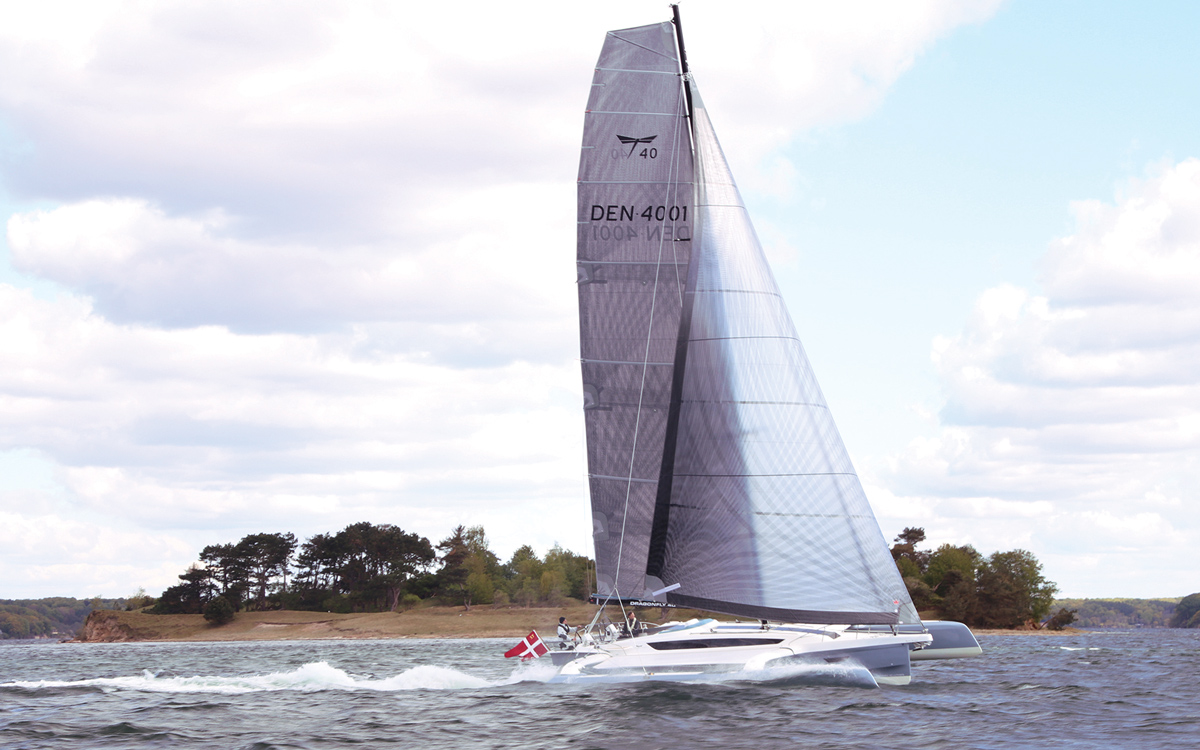
Mainsail handling: Advanced sailing techniques for catamarans and multihulls
A mainsail cannot know whether it is hoisted on a monohull, a catamaran or a trimaran. The principles of sail…

The best bluewater multihulls of all time: a complete guide
What are the best bluewater multihulls for long term cruising? The one you own, or the one you can afford…
Learning a performance catamaran’s sensitivity to weight can be a real learning curve. Compared to cruising catamarans, performance cats tend to be half the weight (or even less). Meanwhile, compared to a monohull the main difference is in the areas where the weight is most concentrated. A monohull’s weight is predominantly in its keel. Almost the entire weight of the boat is concentrated in around 15% of the boat’s length. Conversely, a multihull has no keel, so without that pendulum effect its centre of gravity is higher and less stable. On a multihull the weight is distributed along almost 90% of its length.
In practice, this means that what you carry, both below and above decks, has a big impact on the boat’s performance and safety. The first step is to become minimalists. Summon your inner Marie Kondo and ask yourself “Does this bring me joy? Does this keep me safe?” of every single item that moves from dock to boat. If it doesn’t – don’t take it.

Performance cats are weight sensitive so streamline your possessions onboard. Photo: Carl Newton
Step two is to arrange your belongings evenly around the boat. Ensure you don’t list the boat to port or starboard. Try to keep weight amidships and ideally low down. Avoid loading up the bow lazarettes or aft areas with too much weight.
When sailing, don’t forget that the worst kind place for weight is aloft. Without the keel, you significantly reduce the stability of the boat by having a furled Code 0 (for example) hanging around up the rig. It’s inconvenient to drop it every time, but it’s worth it.
Higher speeds, bigger loads, a lighter boat and higher centre of gravity don’t sound like the safest characteristics, and they aren’t if poorly managed. But you can also use them to your advantage. Being able to sail faster means you sometimes have an option to run away from bad weather.
But there are other safety drills that are worth thinking about ahead of time. What is your MOB recovery plan? With cats’ high freeboard, some owners plan to reverse up to the casualty and pick them up from the steps at the back. But how many have practiced that? Will it involve dropping the mainsail? Could the props injure the casualty? How does the back of the boat behave in a significant sea state? I’d recommend practising this until you have a plan that works for you on your boat with the equipment you have. The same should be said for plans to evacuate the boat, or deal with a fire on board.
If you enjoyed this….
Yachting World is the world’s leading magazine for bluewater cruisers and offshore sailors. Every month we have inspirational adventures and practical features to help you realise your sailing dreams. Build your knowledge with a subscription delivered to your door. See our latest offers and save at least 30% off the cover price.

- Tokyo Express
- Small Boats
- Geelong Model 850
- Plans (all)
- Noosa Plans
- Tewantin Plans
- Geelong Plans
- Daggerboard Plans
- Daggerboards
- Consulting / Drafting
- Terms & Conditions
- Privacy Policy
Select Page
- Catamaran size – how big a boat do you need – ocean sailing
Posted by Tim Weston | Oct 18, 2017 | Building , Cruising | 1
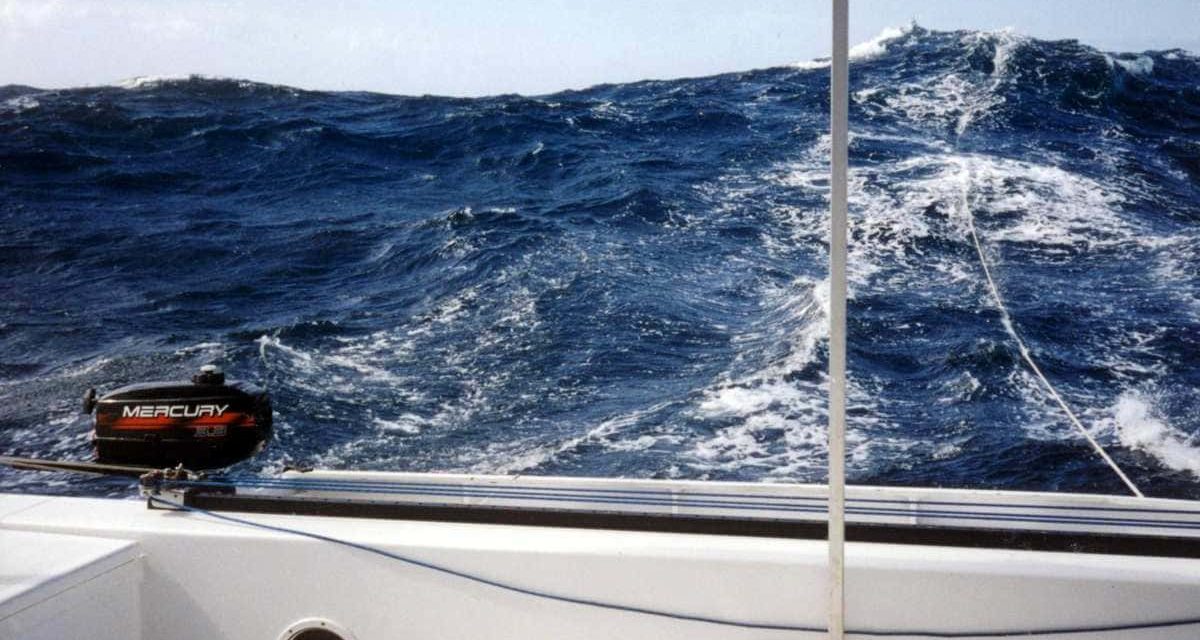
How big is big enough?
How big a cat do you need for ocean sailing? What is the minimum catamaran size to cross an ocean? If you are in the market to build or buy a cat, it is something worth considering.
When I bought my plans and started building I had never been on a cat before, let alone sailed on one. All my decisions were based on what I had read. I created a picture in my mind from all the info I had gathered and the people I had spoken to (not that many). After reading a few books, I plunged in. Finally, it was the right decision, for me and if I replayed my story, I would choose a 40ft cat again for my first boat.
For me, 40ft (12m), is a good round number, for a minimum size for living aboard and extended ocean cruising. It is a size that is often mentioned, including for keel yachts and I tend to agree.
Some Pro’s and Cons
Of course, you can sail around the world in a much smaller boat, and safely too, depending on the design and setup of the vessel. But comfort among other things improves with size. Bigger is always better, but I think the 38-40ft mark is a good compromise. When weighing up the cost, comfort, speed, ease of handling and other factors, it is not a bad starting point.
Some advantages of increasing size
Comfort Stability Speed Room / payload Bridge deck clearance/headroom
Some of the disadvantages of increasing size
The initial cost Maintenance costs Room and cost of berthing in a marina Ease of handling for a solo sailor
Some other thoughts
With smaller boats, having enough headroom to stand up in on the bridge deck is a consideration. Having a bridge deck with 2m headroom (enough for tall people) on a 30ft cat may start to look out of proportion.
I was happy to have the speed potential I did, at times when crossing bars, entering rivers. The ability to surf at 20+kts between the sets kept me in front of big waves. If it was big enough to be dangerous it also had the energy, and the boat had the speed, to keep in front of it. It was at moments like these I was glad I had the size boat I did.
Despite encountering some pretty heavy weather. There were only a couple of times where the thought of capsizing entered my mind. Even though my boat was quite light and had a reasonably big rig, I never felt unsafe on the ocean. With a 40ft boat on the sea, I feel like I am on something half serious.
Advantages of size
After a lot of miles sailing and especially on my Pacific trip, I certainly dreamt of a bigger boat. The main reason was speed and also less pitching. I didn’t need more room I had plenty of room. My preference was and still is, a larger/beamier boat relative to the size of accommodation. Having a big footprint on the water without a lot of weight makes for a fast, easily driven, more stable boat.
I remember talking with a friend who had stepped up from his first boat, a 12m cat that he built himself, to a large racy 15m catamaran he’d made, with minimal accommodation. He said, “they were worlds apart on the water”. “You didn’t even notice bad weather”. Out on deck reefing down half way to New Zealand in big seas. He said the sensation was more that of standing on a big stable platform compared to his “little” 12m cat. It’s all relative.
More length (among other things) dampens pitching, especially for the same weight. But a longer hull also gives you speed, and speed means a lot when you are on the water. No matter how much some people discount speed as not being that important. Nothing makes you grin more than when your boat really starts moving. In my book “ Building Tokyo Express “, I talk more about this. Whenever my speed climbed above 12-13kts, and the yacht started surfing, the ride changed – to pure joy.
Even in a big sea the ride softens when you start surfing (semi-planing), it feels a little like riding on a cushion of air, and the hulls doesn’t slam anymore. It’s an unusual sensation, that really surprised me, in a good way! The boat starts leaving rooster tails behind you. Sitting up on the fore beam as the hulls slice through the water is exhilarating! The voyage changes from “when are we going to get there” to “I don’t want this ride to end”.
If money were my limiting factor, I would instead build the size I want by saving money in other areas. Put a smaller rig on the boat, smaller engines, and/or save money on the fit out (i.e. no anchor winch, etc.). The material costs of extra wood, fibreglass and epoxy don’t add that much to the cost of the boat. It’s the rig and other bits that add the money. You can always add or change those things after if you want too. It’s harder to lengthen your boat once you have built it.
You might also be interested in the following post, which compares catamarans vs monohulls . I hope this post was helpful.
Share this:
- Click to share on Facebook (Opens in new window)
- Click to share on Reddit (Opens in new window)
- Click to share on WhatsApp (Opens in new window)
- Click to share on Pinterest (Opens in new window)
THANK YOU – A HAPPY TIME READING OF YOUR EXPERIENCES AND HELPFUL ADVICES GIVEN. IT WOULD APPEAR FOR A SINGLE HANDER THAT 50FT/15METRES IS THE REAL UPPER LIMIT.
IN YOUR WRITINGS NO MENTION IS MADE OF ELECTRIC WINCHES WITH MANUAL WINCHING BACKUP OF COURSE OF COURSE AS A SAFETY OR NO AIDS FOR FOR EASIER AND OR SAFER SAILING.
THE BIGGEST BOAT I EVER OWNED AND SAILED WAS A 40FT DOUBLE BILGE STEEL KETCH WHICH I SAILED EASILY SINGLE HANDED OUTSIDE UP AND DOWN THE WEST COAST 20 MILES OUT SEA AS FORTY YEAR OLD.. THE HARDEST PART WAS LOWERING THE MASTS TO GO UNDER THE BRIDGES.. THE MASTS WERE TABERNACLED TO SWIVEL BACKWARDS READ LOWERED TO GO UNDER THE BRIDGES TO GO 0N THE SEA OUT AND RETURN. THAT WAS FORTY-SIX YEARS AGO. I NOW SAIL A HOBIE AI OUT AND ABOUT ON THE OCEAN ON MY OWN. I DO ENJOY MY OWN COMPANY.
THANK YOU FOR MAKING MY BLOOD FLOW A LITTLE FASTER AND MY DREAMS A LITTLE CLOSER..MY DREAM IS TO SAIL ANTI CLOCKWISE AROUND THE COUNTRY THAT I LIVE IN. A JOURNEY OF 7500 NAUTICAL MILES. CHEERS M.
What do you think? Leave your comment.. Cancel reply
Search site, new book – just released.
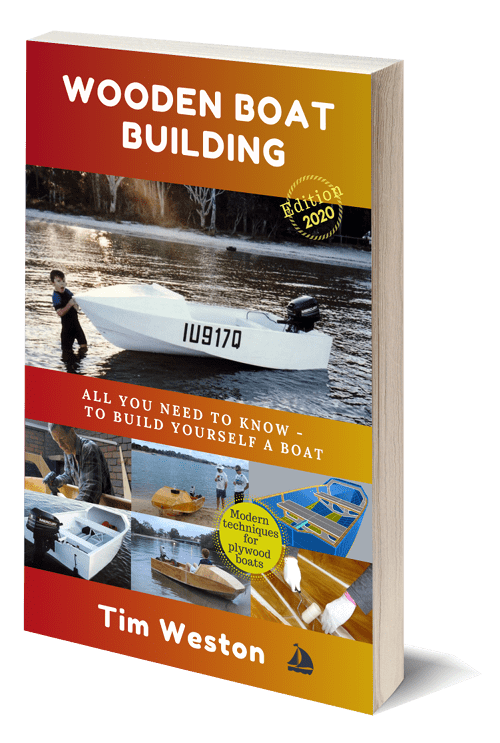
Watch the Video Series – (1 hour & 45 mins)
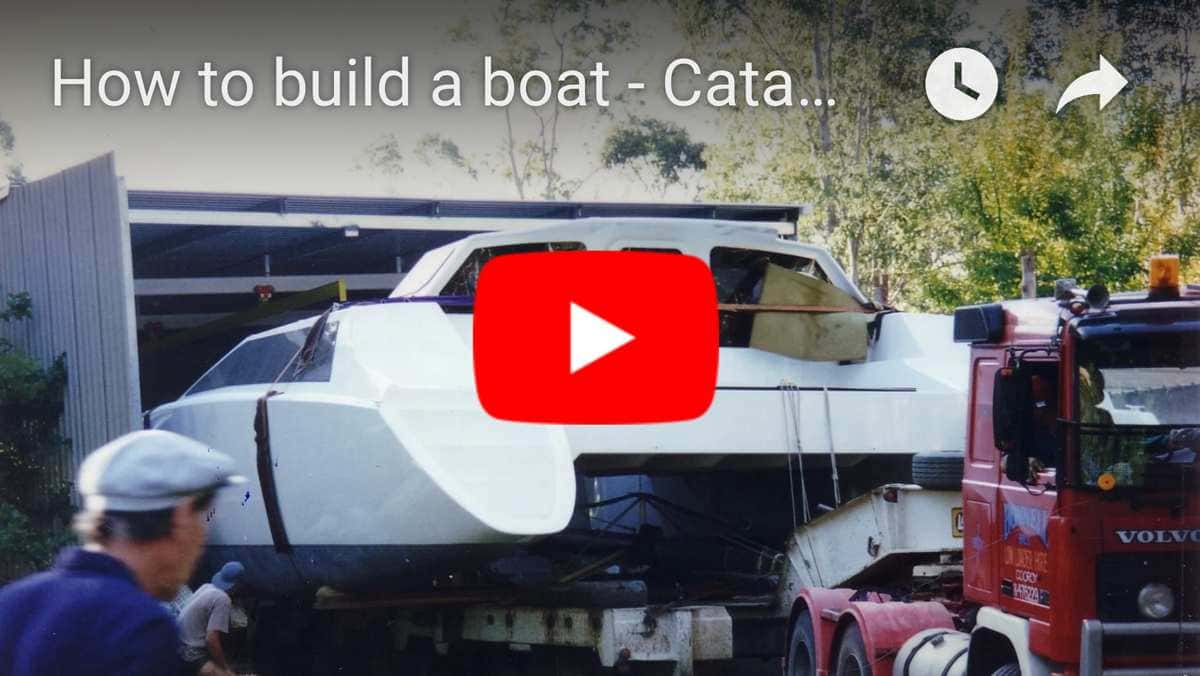
Recent Posts
- Catamaran vs Monohull
- Going fast – in small boats – hull speed.
- Keeping safe – while building your boat
- How much does it cost to build a boat – a 40ft Catamaran?
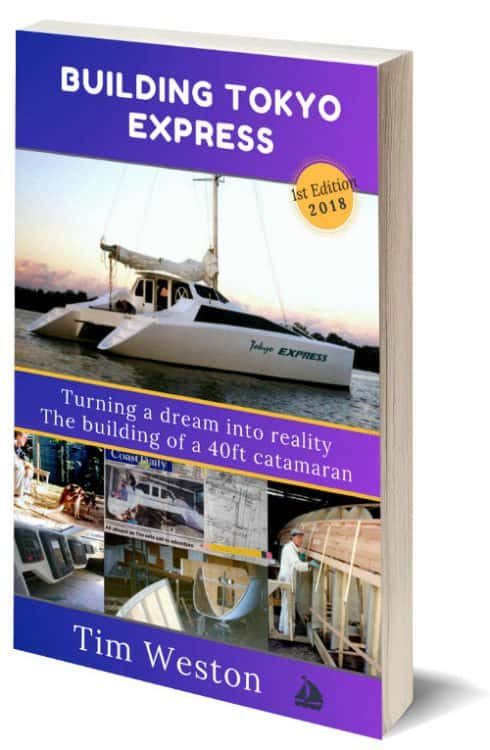
Get the Guide – Free
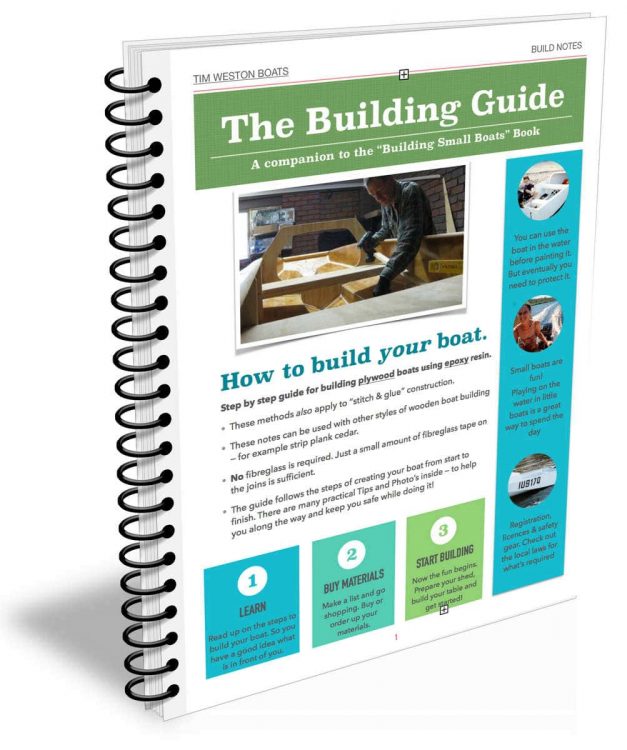
Privacy Overview

How Big of a Catamaran Can a Couple Sail? (Find Out Here)
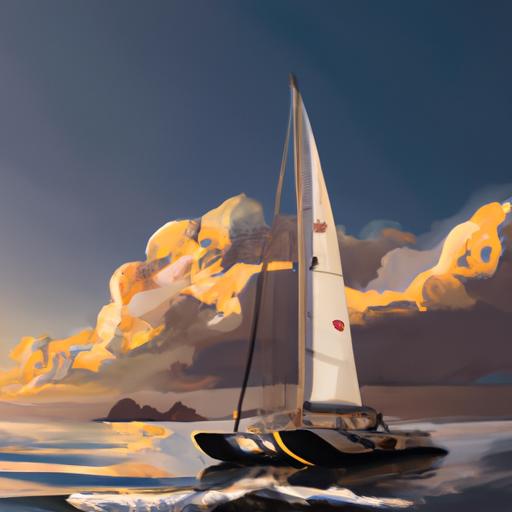
Do you have dreams of sailing around the world with your partner? Or maybe just exploring the local coastline? If so, you might be wondering: just how big of a catamaran can a couple sail? The good news is that, with the right knowledge and preparation, a couple can sail catamarans of all sizes! In this article, we will explore what a catamaran is and the factors that determine the size of catamaran a couple can sail, as well as the types of catamarans suitable for couples, the experience necessary to sail larger catamarans, the catamaran size for different types of sailing, safety considerations, and the advantages of catamarans for couples. So get ready to discover all you need to know to take to the waves with your partner!
Table of Contents
Short Answer
The size of a catamaran a couple can sail depends on the couple’s sailing experience and the amount of time they have to devote to sailing.
Generally, for a couple who are just starting out in sailing, a smaller catamaran, such as a trailerable 22-foot to 24-foot boat, is recommended.
As they become more experienced, they may be able to handle a larger catamaran of up to 44 feet.
Ultimately, the choice of size is up to the couple and their own sailing abilities.
What is a Catamaran?
A catamaran is a type of sailboat that is characterized by its two hulls connected together.
This allows the boat to be more stable and have less drag in the water, which makes it ideal for sailing in a variety of weather conditions.
Catamarans usually have a large deck area, which makes them perfect for couples looking to enjoy the open water.
They are also typically faster than monohull boats, and are more efficient with their fuel consumption.
Catamarans can come in a variety of sizes, ranging from small recreational vessels to larger, more luxurious boats.
For couples, a catamaran can provide a comfortable and enjoyable sailing experience.
Factors That Determine the Size of Catamaran a Couple Can Sail

When deciding how big of a catamaran a couple can sail, there are a few factors to consider.
The first is the couples experience.
If the couple is new to sailing, it is best to start with a smaller catamaran, such as one up to 30 feet in length.
This will give the couple a chance to gain experience while still enjoying the benefits of sailing a larger boat.
As the couple’s experience grows, they can move up to a larger boat.
The second factor is the purpose of the voyage.
If the couple is planning to cruise, they will need a larger catamaran, such as one up to 50 feet in length.
This will provide more room for supplies and a comfortable living space while at sea.
If the couple is planning to race, they may opt for a smaller catamaran, as it will be easier to maneuver and faster to accelerate.
The third factor is the type of sailing environment.
Some catamarans are better suited for certain sailing environments, such as coastal sailing, ocean sailing, or river sailing.
A couple should consider the type of sailing they plan to do and select a boat that is appropriate for the environment.
For example, a coastal cruiser may be better suited for coastal sailing, while an open-ocean catamaran is better suited for ocean sailing.
Finally, couples should consider the design of the catamaran they choose.
Some designs are better suited for certain sailing conditions, such as heavy winds or choppy waters.
Couples should select a boat that is appropriate for their sailing environment and one that is comfortable and easy to maneuver.
Overall, couples can sail catamarans of any size, as long as they consider the factors mentioned above.
With the right experience and the right boat, couples can set sail in a catamaran of any size.
Types of Catamarans Suitable for Couples
When it comes to how big of a catamaran a couple can sail, the size of the boat will ultimately depend on the experience and goals of the individuals.
While some couples may feel comfortable sailing a boat up to 50 feet in length, others may feel more comfortable sailing smaller boats.
Additionally, the type of sailing the couple wants to do will also play a role in the size of the boat they can sail.
Catamarans come in many different shapes and sizes, and some are better suited for certain types of sailing.
For instance, for couples looking to do ocean sailing, a larger catamaran with a greater displacement may be a better choice.
On the other hand, couples looking to do some coastal sailing may find a smaller, more manageable catamaran to be a better choice.
Regardless of the type of sailing the couple wants to do, there are several catamarans that are suitable for a two-person crew.
For instance, a Lagoon 380 is a great option for couples looking for a boat that is easy to maneuver and relatively inexpensive.
The 38-foot boat offers plenty of room for two people and has a proven track record for its sailing capabilities.
For couples looking for more of a luxury experience, the Beneteau Oceanis 50 is a great choice.
This 50-foot boat offers plenty of space for two people and is well-suited for long voyages.
It also comes with many amenities such as a large cockpit, a full galley, and plenty of storage space.
Finally, for couples looking for a more adventurous experience, the Catana 50 is a great choice.
This 50-foot catamaran is designed for long ocean voyages and is well-suited for two people.
It has a great hull design that is both lightweight and strong, making it an ideal choice for sailing in tough conditions.
No matter what type of sailing the couple wants to do, there is a catamaran out there that is suitable for them.
Experience Necessary to Sail Larger Catamarans

When it comes to sailing a catamaran, the size of the vessel is largely determined by the experience of the couple.
For the most part, larger catamarans require more sailing experience than smaller ones.
Thats because the larger the vessel, the more complex the sailing process becomes.
The bigger the boat, the more complex the navigation, sail handling, and trimming.
It also requires more strength and experience to manage the sails and guide the catamaran in rough seas.
That said, a couple who has experience sailing smaller catamarans can often make the transition to larger vessels with some additional training.
Opting for a sailing class or a professional instructor can give a couple the knowledge they need to safely sail a larger catamaran.
Even if a couple has never sailed before, they can likely find a course that will teach them the basics of sailing, as well as how to handle a larger vessel.
Additionally, couples should consider the type of sailing they plan to do.
Depending on the type of sailing, a certain size or type of catamaran may be better suited for the couples needs.
For example, a catamaran for open ocean sailing will likely need to be bigger and more robust than a catamaran for coastal sailing.
Ultimately, the size of the catamaran a couple can sail depends on their experience and the type of sailing they plan to do.
Catamaran Size for Different Types of Sailing
When it comes to choosing the right size of catamaran for a couple, the type of sailing they plan to do is a major factor.
Cruising catamarans, for example, are larger than racing catamarans and typically have more living space and amenities.
Cruising catamarans are also designed to handle heavier loads, making them ideal for long voyages.
For racing, on the other hand, a smaller catamaran is usually best, as it can be maneuvered more quickly and easily.
When it comes to size, a cruising catamaran is usually between 40 and 50 feet in length, while a racing catamaran is usually between 30 and 40 feet in length.
It is important to note that, when sailing a larger catamaran, the crew should have more experience and knowledge to be able to safely navigate the vessel.
No matter what type of sailing a couple is planning, it is important to consider the size of the catamaran they are sailing.
Larger catamarans may be more comfortable, but they also require more experience and knowledge to safely sail.
Smaller catamarans may be more suited to certain sailing environments, but they may not be as comfortable as larger catamarans.
No matter the size, couples should be sure to take the time to research the type of catamaran they are interested in sailing and make sure they have the necessary experience and knowledge before setting sail.
Safety Considerations

When it comes to sailing, safety should always be a top priority.
A couple sailing a catamaran needs to consider the size of the boat in relation to their experience level and the type of sailing they plan to do.
Generally speaking, a larger catamaran requires more skill and experience to safely navigate.
Smaller catamarans are easier to handle and may be a better option for less experienced sailors.
It is also important to consider the type of sailing the couple plans to do.
If they plan to sail in open ocean waters, they should look for a larger catamaran that is built for rougher conditions.
If they plan to sail in calmer waters, they may be able to get away with a smaller boat.
Additionally, couples should research the safety features of each catamaran they are considering to ensure that it is equipped with the proper safety gear and has all the necessary safety features.
Finally, couples should be sure to take a safety course before setting sail.
This will help ensure that they are familiar with the safety procedures for sailing and will also give them the skills they need to handle any unexpected situations that may arise.
With the right safety precautions and the right boat, couples can confidently set sail in a catamaran of any size.
Advantages of Catamarans for Couples
When it comes to sailing, couples have a variety of options. But if youre looking for a boat that offers ultimate freedom and flexibility, a catamaran is a great choice. Catamarans provide a unique sailing experience, offering the perfect combination of stability, speed, and comfort. Here are some of the advantages of catamarans for couples:
1) Stability: Catamarans feature two hulls connected by a central beam, which makes them exceptionally stable on the water. This makes them ideal for couples who want to enjoy a relaxing day of sailing without worrying about the boat capsizing or rocking too much.
2) Speed & Efficiency: Catamarans are known for their speed and efficiency in the water. With two hulls instead of one, they are able to move through the water with ease, making them perfect for couples who want to explore more areas and cover greater distances in less time.
3) Comfort: Thanks to their two hulls, catamarans provide ample space and comfort for couples. The wide-open decks and ample cabins make them perfect for couples who want to enjoy the sailing life without sacrificing comfort.
4) Versatility: Catamarans are incredibly versatile boats. They are perfect for day trips, weekend getaways, or even extended voyages. Couples can customize their catamaran to suit their needs, adding amenities and equipment as needed.
Overall, catamarans provide couples with a unique and enjoyable sailing experience.
With the right boat and the right experience, couples can set sail with confidence and explore the open waters with ease.
Final Thoughts
In conclusion, a catamaran is an ideal boat for couples looking to sail.
The size of the catamaran a couple can sail depends on a variety of factors, such as their experience and the purpose of the voyage.
Couples should also consider the type of sailing they plan to do, as some catamarans are better suited for certain sailing environments.
For couples looking to embark on a sailing adventure, understanding the size of catamaran they can sail is essential for a safe and enjoyable voyage.
So what are you waiting for? Start exploring the possibilities and make your sailing dreams come true!
James Frami
At the age of 15, he and four other friends from his neighborhood constructed their first boat. He has been sailing for almost 30 years and has a wealth of knowledge that he wants to share with others.
Recent Posts
When Was Banana Boat Song Released? (HISTORICAL INSIGHTS)
The "Banana Boat Song" was released in 1956 by Harry Belafonte. This calypso-style song, also known as "Day-O," became a huge hit and remains popular to this day for its catchy tune and upbeat...
How to Make Banana Boat Smoothie King? (DELICIOUS RECIPE REVEALED)
To make a Banana Boat Smoothie King smoothie at home, start by gathering the ingredients: a ripe banana, peanut butter, chocolate protein powder, almond milk, and ice. Blend the banana, a scoop of...
- Motorcycles
- Car of the Month
- Destinations
- Men’s Fashion
- Watch Collector
- Art & Collectibles
- Vacation Homes
- Celebrity Homes
- New Construction
- Home Design
- Electronics
- Fine Dining
- Les Marquables de Martell
- Mira Villas
- Panther National
- Reynolds Lake Oconee
- Saratoga Spring Water
- Wynn Las Vegas
- 672 Wine Club
- Sports & Leisure
- Health & Wellness
- Best of the Best
- The Ultimate Gift Guide
- Meet Stormy Knight, the Sleek New Batmobile-Style Jet Ski Fit for a Superhero
Limited to only 27 units, the sleek watercraft costs $250,000 a pop.
Rachel cormack.
Digital Editor
Rachel Cormack's Most Recent Stories
- A Pristine 1995 Bentley That Starred in ‘The Crown’ Is up for Grabs
- This Rare 10-Carat Pink Diamond Could Fetch Up to $12 Million at Auction
- Share This Article

The Batboat has been reimagined for the 21st century.
Related Stories
- This New Mercedes Concept Is an Ultra-Sleek Roadster With a Formula 1 Halo
- This One-of-a-Kind Bugatti Chiron Has a Paint Job Inspired by the Legendary Type 55

The Stormy Knight can seat up to four passengers, so there is plenty of space for your sidekick, Robin. It is also autonomous and offers Garmin navigation with iOS and Apple watch voice command, meaning you can direct it by saying “Hey GT, come get me and Catwoman,” for instance. Each Stormy Knight is tailored to suit individual preferences, too.
T3MP3ST’s fleet also includes a larger tender model . Fitted with an RIB hull, the 30-footer can serve as a people-carrying tender and a tow-in vehicle for big surf spots like the Mavericks Marine Reserve. The 5,000-pound beast can carry eight seafarers, reach 40 knots at full tilt, and cruise for up to eight hours. Batman is, of course, more suited to the high-speed GT.
Rachel Cormack is a digital editor at Robb Report. She cut her teeth writing for HuffPost, Concrete Playground, and several other online publications in Australia, before moving to New York at the…
Read More On:
- Electric Vehicle
More Marine

Watch: Arc’s Speedy New Electric Wakeboat Has Enough Juice for a Full Day of Surfing

Watch: This Sporty Hybrid Catamaran Uses AI for Greener Cruising on the High Seas

A Legendary 36-Foot Cigarette Powerboat Is Heading to Auction This Summer

The World’s First Superyacht to Use Methanol Fuel Is Now Cruising the High Seas

Pebble Beach Concours d'Elegance
AUG 14 - 19 Get behind-the-scenes access to this remarkable week honoring automotive brilliance.
Give the Gift of Luxury
Latest Galleries in Marine

‘Monster Munch’ Cigarette 36 in Photos

K Superyacht in Photos
More from our brands, prada ‘villains’ runway show, explained: the dramatic catwalk finale with willem dafoe, adrien brody and more hollywood bad guys gets viral afterlife, ncaa, power five ok $2.7 billion antitrust settlement, ‘all we imagine as light’ review: a glowing portrait of urban connection and unexpected sisterhood, the price of a dollar and the return of the collector’s market, the best yoga mats for any practice, according to instructors.
Wang Chung Was Surprised to Learn John Mulaney Used Their 1985 Song as His Netflix L.A. Talk Show Theme
By Michael Schneider
Michael Schneider
Variety Editor at Large
- Paul Scheer, June Diane Raphael to Host This Year’s Humanitas Prizes Event (EXCLUSIVE) 5 hours ago
- Breaking Down Upfronts: How Networks and Streamers Used A-Listers, Athletes and ‘Texas Hold ‘Em’ to Entice Ad Buys 5 hours ago
- Super Bowl LVIII on CBS, Disney’s ‘Toy Story Funday Football’ Lead This Year’s Sports Emmy Winners 17 hours ago

Wang Chung had no idea John Mulaney ’s six-episode Netflix talk show “Everybody’s in LA” would use their 1985 song “ To Live and Die in L.A. ” as its theme song — but they’re thrilled he did.
“It’s a total surprise that it’s blown up in the way that it has,” says Wang Chung lead singer Jack Hues, who first heard of the usage on “Everybody’s in LA” via “the guy who does our merch.”
Popular on Variety
“Bill Friedkin said to us in the initial conversations that he didn’t want a theme song,” Hues recalls. “He just wanted instrumental stuff. But once I’d seen the film, the song just kind of popped out, despite his warnings.”
Friedkin eventually embraced the track, even though Hues says the band’s A&R team at Geffen Records didn’t quite know what to do with it. Unlike most songs, the chorus of “To Live and Die in L.A.” goes down an octave. “I think in a way the song is a bit upside down, a bit inverted, in that it’s got a heavy verse, and a gentler chorus,” Hues says. “Usually, it’s the other way around.”
Back in 1985, “To Live and Die in L.A.” narrowly missed the top 40, peaking at No. 41 on the Billboard Hot 100.
“It was not a big hit at the time,” Hues says. “It’s one of those songs I think that people find for themselves, rather than it being pushed down your throat. So, it has a more kind of intimate feeling for a lot of people.”
The full “To Live and Die in L.A.” soundtrack featured vocal tracks on one side, and the instrumentals that Friedkin wanted on the other. Wang Chung followed it up with 1986’s “Mosaic,” their most successful album release (featuring their now-classic “Everybody Have Fun Tonight”).
“At the time, we were getting a lot of pressure from the record company to come up with the follow up hit song to ‘Dance Hall Days’ from our [1983] ‘Points on the Curve’ album,” Feldman remembers. “We were sort of slightly struggling to come up with what they considered a big enough hit. So, when Friedkin came in with this project — which was literally the opposite, ‘I don’t want any songs. I just want some gritty instrumental longform music with no vocals’ —it was a breath of fresh air. It’s really stimulating thing to do. The record company was not particularly excited about it. But once we had a title track, they started to get more interested.”
And although the title track wasn’t an immediate smash, it continued to get wider exposure as the film lived on in video rentals. And then, in 1987, Michelob used the song for an ad campaign (with the tag line, “The night belongs to Michelob”) — further cementing its legacy.
“I think we re-recorded it with some slightly different lyrics,” Hues says. “Because my lyric about ‘God not being in heaven’ was probably not deemed appropriate for a beer commercial.”
As Wang Chung has continued to tour, both bandmates say “To Live and Die in L.A.” now gets some of the best reaction from audiences.
“I think that’s why it’s endured really well with our fans,” Feldman says. “Because I think it’s got that something a bit different so it kind of sticks out in a bit more. When we play it live, people love it.”
Hues says the band and Friedkin kept in touch through the years; they last saw the filmmaker in 2019, when Hues and Feldman were on a panel with him in the U.K. “Whenever I was in L.A. I’d see him and sometimes we go to the L.A. Philharmonic,” Hues says. “He was a fascinating man, a really super educated intellectual guy.”
A month after Friedkin died last year, Wang Chung played the Greek Theatre and dedicated their performance of “To Live and Die in L.A.” to him.
The Mulaney talk show actually isn’t the only needle drop that Wang Chung has recently enjoyed in the streaming world: “Dance Hall Days” also plays a role in Amazon Prime Video’s film “The Idea of You,” as the characters played by Anne Hathaway and Nicholas Galitzine dance and sing along to the song. (Yes, the Wang Chungassaince is real, so say it together: Everybody Wang Chung Tonight .)
“There’s something about our music that sort of fits well into TV and film,” Feldman says. “We’ve been pretty blessed with how much usage we’ve had in our music.”
Wang Chung is currently embarking on the “Abducted by the 80s” tour with the Motels and Naked Eyes. They’ll also be on a different tour that hits Los Angeles in August — and at that point, they hope to get Mulaney to drop by.
“We’re going to have to reach out to him and set something up,” Hues says. “I’d like to have a conversation with John. At least just to thank him. It’s been great for us. And it clearly kind of put a stamp on his show that gives it something strong.”
More From Our Brands
The 7 best things to buy from amazon this month, according to our editors, this rare 1969 de tomaso was the marque’s second production car. it’s now up for grabs., tnt to sublicense college football playoff package from espn, the best loofahs and body scrubbers, according to dermatologists, joe locke talks heartstopper season 3 crush, witchy agatha all along role, verify it's you, please log in.

COMMENTS
A mega catamaran is a large, luxurious, professionally crewed motor catamaran ranging from 79 ft to more than 590 ft in length. How much does a super catamaran cost to own? Mega catamarans (1000 feet+) are made entirely bespoke by big shipyards and typically cost between $15,000,000 up to $100,000,000.
6. Sarha ( 137 Ft.) Registered at the Port of George Town and sailing under the Cayman Islands Flag, Sarha is a 40 m motor yacht built by Sea Management, fabricated in Australia and launched in 1989. With its sleek white exterior and blue windows, she is a piece of sheer beauty and class.
A catamaran ( / ˌkætəməˈræn /) (informally, a "cat") is a watercraft with two parallel hulls of equal size. The distance between a catamaran's hulls imparts resistance to rolling and overturning. Catamarans typically have less hull volume, smaller displacement, and shallower draft (draught) than monohulls of comparable length.
Short Answer. Catamarans come in a variety of sizes, ranging from small, single-person vessels to large, ocean-going vessels. The length of a catamaran can range from 8-50 feet, with the average size being between 20-30 feet. Bigger catamarans can have multiple cabins and berths and can even be used for overnight trips.
The best catamarans for sailing around the world include: Lagoon 42. The Fountaine Pajot Ipanema 58. Manta 42. Catana 50. Dolphin 42. Gunboat 62. These cats focus on speed, safety, and comfort for longer journeys. This article will show you the seventeen best catamarans for long journeys, and why they're the best.
Locate the main halyard (rope used to raise or lower the mainsail) in your cat and begin raising the mainsail. If you have enough manpower, you can begin pulling it by hand (wear a pair of hand gloves or use a winch for this). Pull it until it is perfectly positioned on the mast. Your mainsail is now hoisted.
In the world of large sailing multihulls, boats like "Hemisphere" the world's largest catamaran and McConaghy's Trimaran, the 140ft "Adastra", still rule the big catamaran market. Any other large multihulls have a steep hill to climb to compete. However, we have seen more interesting large catamaran designs come to market lately like the Lagoon Seventy7, […]
Live out your sailing dreams aboard the Leopard 50. This catamaran is everything you envisioned, plus so much more. With a never-before-seen lounging flybridge of this size, the Leopard 50 incorporates the best attributes from its predecessor and 2012 Boat of the Year, the Leopard 48. Now, with even more living space and options, your journey ahead is boundless.
Leopard 42. Built by Robertson & Caine and designed by naval architects Simonis Voogd, the Leopard 42 utilizes superior finishes and materials, creating a one-of-a-kind vessel that balances comfort, performance and ease of handling. A thoughtful design process ensures every feature and function has been anticipated, with minimal customization ...
The first CM46 is a full carbon racing version destined for an Auckland-based owner and is due to launch early 2021. The second boat (for Wadhams) has a more cruising-oriented spec. Prices ex VAT ...
Fountaine Pajot, one of the foremost builders of sailing catamarans, unveiled their biggest "Super Catamaran" ever: the Thira 80. The release comes on the tail of an ever-increasing trend in the catamaran market—the bigger-the- better era. With Sunreef, Lagoon, and Gunboat all making boats in the 70 to 80-foot range, these companies ...
Gunboat 62. gunboat_catamarans. An original performance catamaran cruiser from the iconic Gunboat manufacturer, the Gunboat 62 has truly cemented its place as one of the best catamaran sailboats to ever grace the oceans. Honestly speaking, this cat-inspired a whole range of other incredible boats including HH66 Catamaran and the Balance 526.
Your catamaran will feel like a big tennis court amidst the maelstrom. Illustrations by Dick Everitt, Photos courtesy of Lindsay Turvey. Tags. terms: SAIL Magazine Sailing storm sails catamarans Weather cruising MHS storms tactics sail. Related. Sail Racing. Racing News: The IMOCA fleet Returns to the United States.
Catamaran sailing vessels for sale on YachtWorld are listed for a range of prices from $54,143 on the relatively moderate end all the way up to $7,548,599 for the most unique, one-of-a-kind yachts. Catamaran By Condition. Used Catamaran 1,346 listings . New Catamaran 474 listings .
August 30, 2022. Catamarans are generally longer than monohulls, but their accommodations and handling vary widely between sizes. The best size catamaran to sail around the world is 45 to 50 feet. The smallest catamaran with space for long-term provisions and a cabin is around 30 feet in length, and a 55 to 60-foot catamaran is the largest that ...
Big catamarans in the mainstream; See What Our Clients Say. Facebook Youtube Instagram. For more than 30 years, we have been a part of the catamaran community and created Catamaran Guru™ to encourage and educate all the aspiring sailing out there. We understand the dream of traveling the world by catamaran and created a one-stop-shop to make ...
Catamarans in the 35-40' size range will typically include 2 or 3 berths, for up to 4 people to live onboard comfortably, or perhaps 6 for shorter durations. As you move up into the 40-50' range that may increase to 3 or 4 berths, with one of them being a large master suite holding a queen sized bed. Larger catamarans are likely to have ...
1 Sail at higher angles to build up apparent wind speed (AWS) and boat speed. 2 Soak downwind as the apparent wind angle (AWA) surges forward with the acceleration. 3 Drive the boat back slowly ...
Attach one line to each of the forward cleats and bring the loose ends to the center. Pick up the mooring with a boathook. String one line through the eye and bring it back to the same cleat. Repeat on the other side, keeping the lines the same length so the cat is centered.
We're often asked what level of performance you give up when you buy a cruising catamaran. The simple answer is there isn't a large difference in performance...
1986 Stiletto 27. US$15,000. The Multihull Source | Pocasset, Massachusetts. Request Info. <. 1. >. * Price displayed is based on today's currency conversion rate of the listed sales price. Boats Group does not guarantee the accuracy of conversion rates and rates may differ than those provided by financial institutions at the time of transaction.
Having a big footprint on the water without a lot of weight makes for a fast, easily driven, more stable boat. I remember talking with a friend who had stepped up from his first boat, a 12m cat that he built himself, to a large racy 15m catamaran he'd made, with minimal accommodation.
The size of a catamaran a couple can sail depends on the couple's sailing experience and the amount of time they have to devote to sailing. Generally, for a couple who are just starting out in sailing, a smaller catamaran, such as a trailerable 22-foot to 24-foot boat, is recommended. As they become more experienced, they may be able to ...
Best All-Inclusive Resort In St. Thomas Overall: Bolongo Bay Beach Resort. Best High-End All-Inclusive Resort In St. Thomas: The Ritz-Carlton, St. Thomas. Best Boutique All-Inclusive Resort In St ...
The 1,300-pound speed machine is also equipped with a 100 kWh modular battery and a 350 hp electric motor, meaning that it can tear across the ocean quietly and sans emissions. The Stormy Knight ...
Wang Chung had no idea John Mulaney 's six-episode Netflix talk show "Everybody's in LA" would use their 1985 song " To Live and Die in L.A. " as its theme song — but they're ...